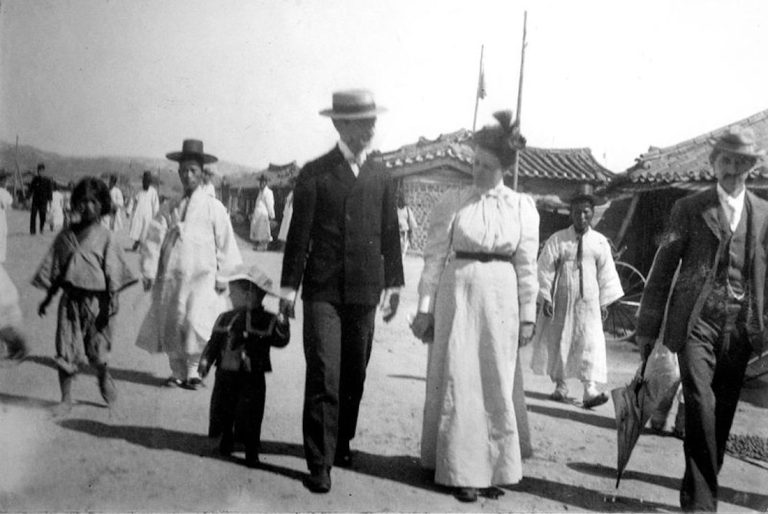
xxx Boxer Rebellion
New York, N.Y. — xxx [draft]
900: The Boxer Uprising
In the late 19th century, anti-foreign sentiments merged with rural unrest and mystical cults to give rise to the Boxer movement. Practicing martial arts and espousing a slogan of “support the Qing, destroy the foreign,” the “Boxers United in Righteousness” targeted all foreigners and Chinese Christian converts, who suffered violent attacks.
The Uprising reached a peak in the spring and summer of 1900 when Boxer forces marched on Beijing, with the support of the Qing court. For two months the Boxers occupied the capital and besieged the foreign legation district, where the foreign community and a large group of Chinese Christians barricaded themselves within the legations.
The foreigners managed to resist repeated Boxer attacks until a multinational force finally fought its way in from the coast and reached Beijing, lifting the siege. U.S. marines played a key role in defending the legations during the siege and also joined the multinational force that crushed the Boxers.
1901: The Boxer Protocol Signed
After defeating the Boxers, the foreign powers forced the Qing to submit to a punitive settlement that included a huge indemnity ($333 million) to be paid to the foreign nations. This essentially bankrupted the Qing government, which already faced serious financial difficulties.
Meanwhile, outside the walls of Beijing, Christian missionaries flooded the Chinese countryside, establishing local schools and hospitals as they sought to convert local populations to Christianity. By 1900, the Presbyterian Church ran 10 hospitals, 150 schools, and 51 churches in China. Shandong (Shantung) Province, the cradle of the Boxer Rebellion, was home to 55 Christian schools.[5]
In December 1899, Minister Conger wrote to Secretary Hay of “a very critical state of affairs among the missionaries and their converts in Shandong.”[6] This fragile state was the result of extreme poverty among Chinese workers, and the workers blamed the Westerners for their misfortune. Western modernization efforts, especially the railroads, had rendered entire Chinese industries obsolete. To make matters worse, the Yellow River had flooded in 1898, wiping out harvests in Shandong. Then, in 1899, a drought arrived and stretched into 1900. Displaced Chinese workers had two places to turn for support: the church or a secret society.[7]
The Yihequan (I Ho Ch’uan), the “Righteous and Harmonious Fists,” had no official leader. It was a people’s movement united in the belief that the foreigners needed to be eliminated from China. Members of this secret society believed they could make themselves impervious to physical harm, including bullets, through practicing martial arts that inspired the name “Boxers.” They wore red sashes, and their ritual demonstrations coupled with a dramatic message—“Support the Qing, exterminate the foreigners”—proved to be an effective recruiting method.[8]
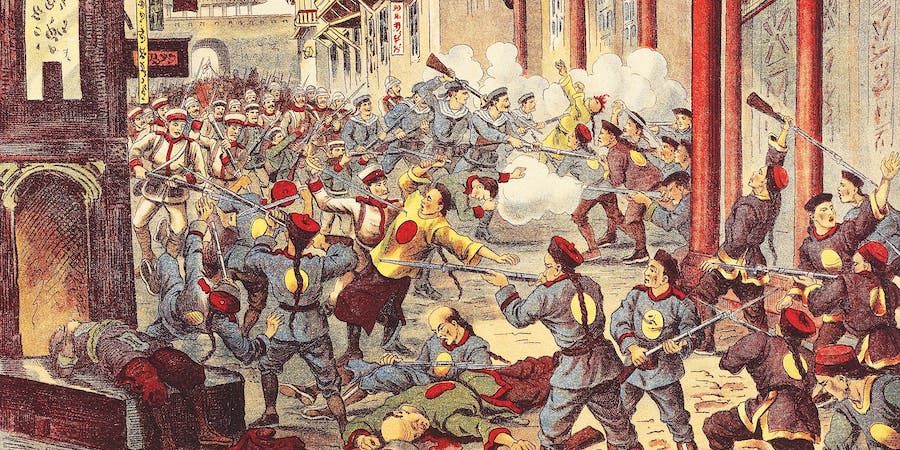
The Boxer Rebellion was a violent uprising of Chinese citizens against Western influence in their country. The rebellion was instigated in 1900 by a secret organization known as the Society of Righteous and Harmonious Fists, but the tensions that fueled the violence had been simmering since China’s defeat in the Opium Wars nearly half a century before. At its peak the rebellion even had the support of China’s then-empress, but it was violently suppressed by a multinational alliance. The Boxer Rebellion lasted only a year, but its impact on Chinese history and the ruling Qing dynasty, were profound.

By analyzing questions, you can see patterns emerge, patterns that will help you answer questions. Qwiz5 is all about those patterns. In each installment of Qwiz5, we take an answer line and look at its five most common clues. Here we explore five clues that will help you answer a tossup on The Boxer Rebellion.
SOCIETY OF RIGHTEOUS AND HARMONIOUS FISTS The Society of Righteous and Harmonious Fists was a secret society that emerged primarily in the Northern Chinese province of Shandong in the 1890s. Also known as the Yihequan, the Society earned the nickname “boxers” from their elaborate martial arts rituals. The leadership of the Boxers believed that these rituals would render them immune to bullets. The Boxers had been mounting attacks on Christian missionaries and Christian converts for several years before exploding into full-out rebellion in 1900 and attacking Beijing.
DOWAGER EMPRESS
At the time of the Boxer Rebellion, the Dowager Empress Cixi had ruled as regent twice—first for her son and later for her nephew. When that nephew, Guangxu, launched the poorly-received Hundred Days’ Reforms in 1898, the Empress retook the throne with the help of Chinese conservatives. The Empress supported the Boxer movement as it gained power, but after it fell she was forced to agree to a humiliating indemnity. The terms of settlement limited Qing military power even further, dismantling the Dagu Forts that were meant to defend against Western invaders.
CLEMENS VON KETTELER
One of the most publicized deaths of the Boxer Rebellion was that of German ambassador Baron Clemens von Ketteler. The Boxer forces arrived in Beijing in June of 1900. Ketteler enraged both the Boxers and the Imperial army forces by shooting a child. During the ensuing street fighting Ketteler was shot by an army captain named En Hai.
KANSU BRAVES
The Kansu Braves were a unit of 10,000 Chinese Muslim soldiers stationed in Beijing during the Boxer Rebellion. Commanded by the virulently anti-Western General Dong Fuxiang, the Kansu Braves joined the Boxers early on in the fighting in Beijing. In addition to killing Clemens von Ketteler they also tore apart Japanese ambassador Sugiyama Akira. Although the Braves were initially dismissed as “10,000 Islamic rabble” they proved their mettle in their one major engagement with foreign forces outside of the walls of Beijing—The Battle of Langfang.
EIGHT-NATION ALLIANCE
Recent Posts
What was China’s Boxer Rebellion? (Aug. 15, 2020)
Arrival of the Navy, May 1900
The United States took control of the Philippines from Spain after its victory in the Spanish-American War in 1898. Cavite, Philippines, provided a strategic naval base, allowing the United States to project its power toward Asia.
When Boxer unrest prompted the U.S. minister at the Beijing legation to request naval support, the gunboat Wheeling departed the Philippines in March 1900 to patrol the northern coast of China, joining ships of European navies at the port city of Dagu.[10] At the end of April, Wheeling was relieved by Newark, the first modern cruiser in the U.S. Navy fleet. When on May 28 and 29 Boxers burned railroad stations including Fengtai, which connected Beijing (and thus the legations) to the coast, Newark was positioned to provide a relief force.
The force that disembarked from Newark at Dagu on 29 May was comprised of two Marine detachments under the command of Captain John T. Myers, nicknamed “Handsome Jack.” Myers and his detachment of 25 Marines had been aboard the battleship Oregon, which a month later grounded on an uncharted rock in the Bohai (Pechili) Strait.[11] They had received orders on 24 May to transfer to Newark, joining a detachment of 23 Marines, five sailors, and U.S. Navy Assistant Surgeon Thomas M. Lippitt under the command of Captain Newt Hall, USMC.[12]
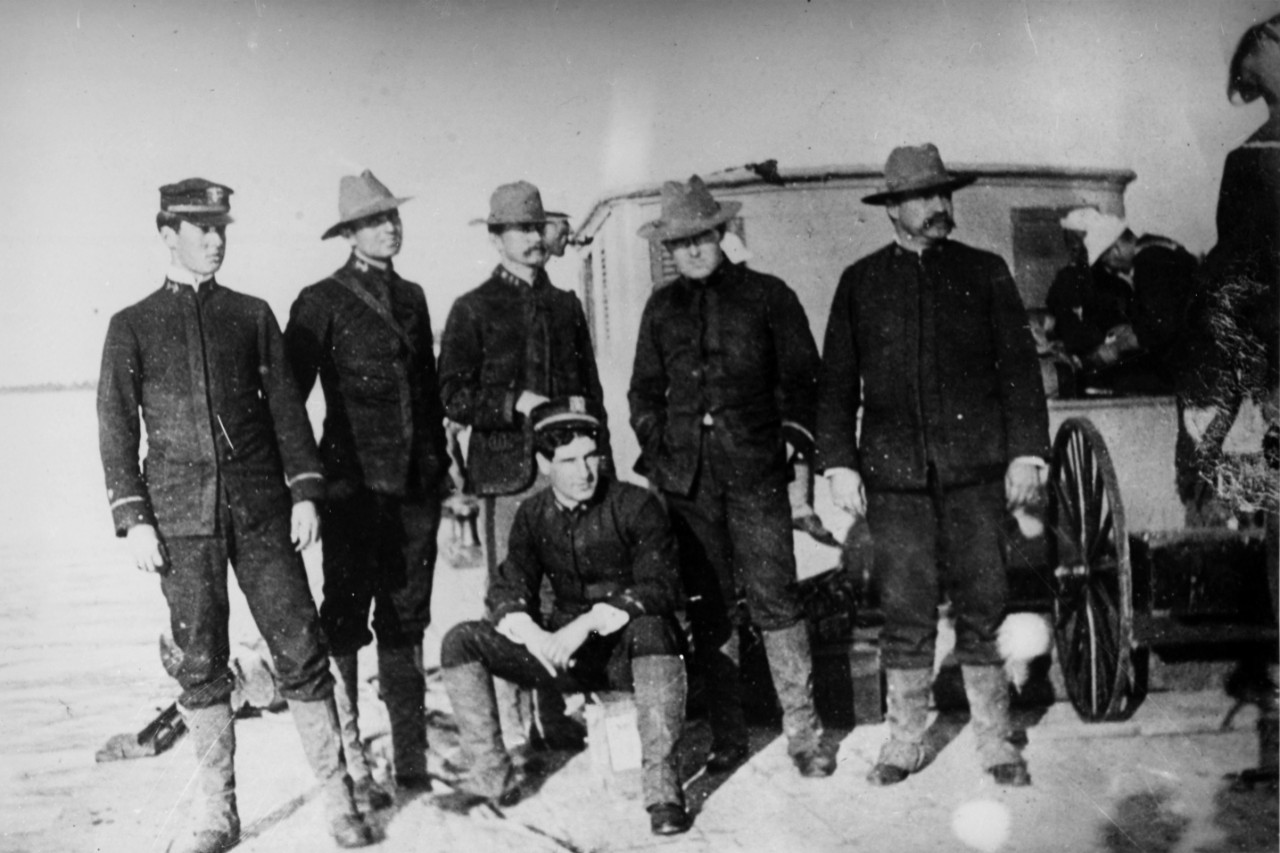
Officers of Newark on a ship on the Hai River en route to Tianjin. Left to right: Midshipman C. E. Courtney, Ensign D. W. Wurtzbaugh, Captain Newt H. Hall (USMC), Midshipman Joseph K. Taussig, Assistant Surgeon Thomas M. Lippitt, and Machinist Daniel Mullan. (NHHC NH-45347.)
On 31 May, Myers and his detachments arrived by train at Beijing, along with a Colt machine gun with 8,000 rounds and 20,000 rounds of rifle ammunition. They were followed by a train carrying 79 British marines, 75 French sailors, 72 Russian sailors, 51 German marines, 39 Italian sailors, 30 Austrian marines, and a 23-man Japanese special navy landing force. Captain Bowman H. McCalla from Newark accompanied the U.S. relief force to the legations, met with the U.S. minister Conger on 1 June, and returned to Tianjing, where his forces were stationed, on 2 June.[13]
Soon, Boxer destruction of railroads would make further relief impossible. Myers and his detachments, along with the international forces, would defend the legations from Boxers and Chinese soldiers during a 55-day siege.
Seymour Expedition, June 1900
On 9 June, the British minister at Beijing sent a telegram to the commander in chief of the British Royal Navy’s China Station, Admiral Sir Edward Seymour, with an urgent message: “Unless those at Pekin were relieved soon, it would be too late.”[14] Seymour responded immediately, leaving Dagu with a battalion of British sailors and marines and arriving in Tianjin early on 10 June to assemble an international relief force.
Numbers vary slightly, but according to the Secretary of the Navy’s report on the expedition, Seymour’s expedition force totaled 2,066—915 British, 450 Germans, 312 Russians, 158 French, 54 Japanese, 40 Italians, 25 Austrians, and 112 Americans commanded by Captain Bowman H. McCalla.[15]
The Secretary of the Navy’s report also notes that trains carrying the relief column left promptly at 0930 local time. However, an account by Midshipman (and later vice admiral) Joseph K. Taussig details how McCalla insisted the Americans travel in the first train, and got his way, but the squabble delayed the trains from leaving the station until early afternoon. Such tension among the allied forces was commonplace throughout the summer campaign.[16]
Five trains left the Tianjin station on 10 June, the final one a supply train Seymour planned to send between his column and Tianjin. That first day, the journey through the countryside was relatively smooth, the train passing an encampment of Chinese imperial troops under General Nie Shicheng (Nieh Shih-cheng), who allowed the allies to continue undisturbed but sent a telegram to Beijing.
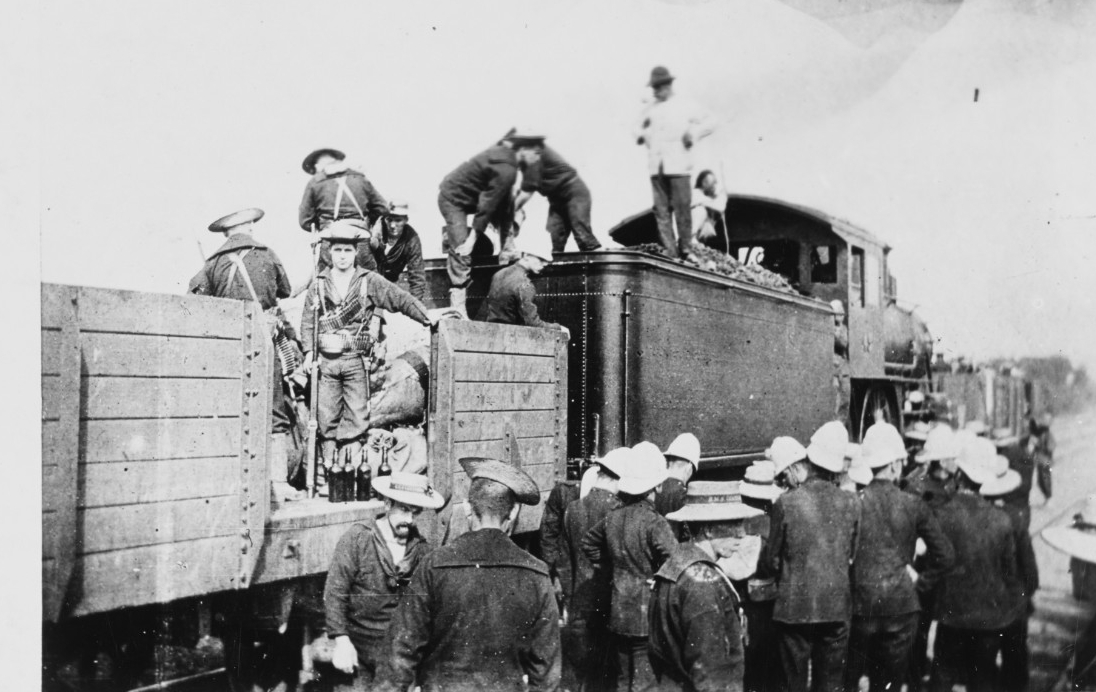
Train belonging to the Seymour Expedition. (NHHC USN-901029.)
This peaceful train ride was short-lived. The allied forces soon encountered torn up train tracks that required the troops to camp overnight as they made repairs. The destruction was an organized effort by Boxers under the local leader Ni Zanqing, whose strategy was to slow down the troops so they were sitting ducks for attacks.[17]
The British and Americans, aided by Chinese laborers, had to repair the railway. Sailors carried ties for several hundred yards, dug up the rocky road for the ties, lifted the rails, put them in place, and drove the spikes. Taussig recorded in his diary that the sailors were not “very successful spike drivers,” so this task was performed by the Chinese. “I doubt if a Naval force ever had to build a railroad before, and I also doubt if any force of equal size ever laid so much track per unit of time,” Taussig wrote.[18]
On 11 June—the day Seymour had hoped to arrive in Beijing—the Americans were repairing track near Luofa (Lofa) station when a small party of Boxers snuck up on the train. A British patrol sounded the alarm. McCalla ordered the Americans to form a skirmish line and advance on the Boxers, who wore red caps, belts, and anklets, and carried white and red flags. The Boxers were armed with either large knives or long spears, and they advanced slowly, making gestures they believed would protect them from bullets. Under the fire of the Americans and the British, all the Boxers were shot in the span of a few minutes.[19]
On 12 June, while the main force made repairs at Langfang, Seymour sent a force of about 50 officers and men north to prevent damage to the railroad at Anding (Anting). The force encountered repeated attacks, culminating in a charge by 450 Boxers. The Boxers lost 150 men, but succeeded in driving back the allied troops, who were running low on ammunition.
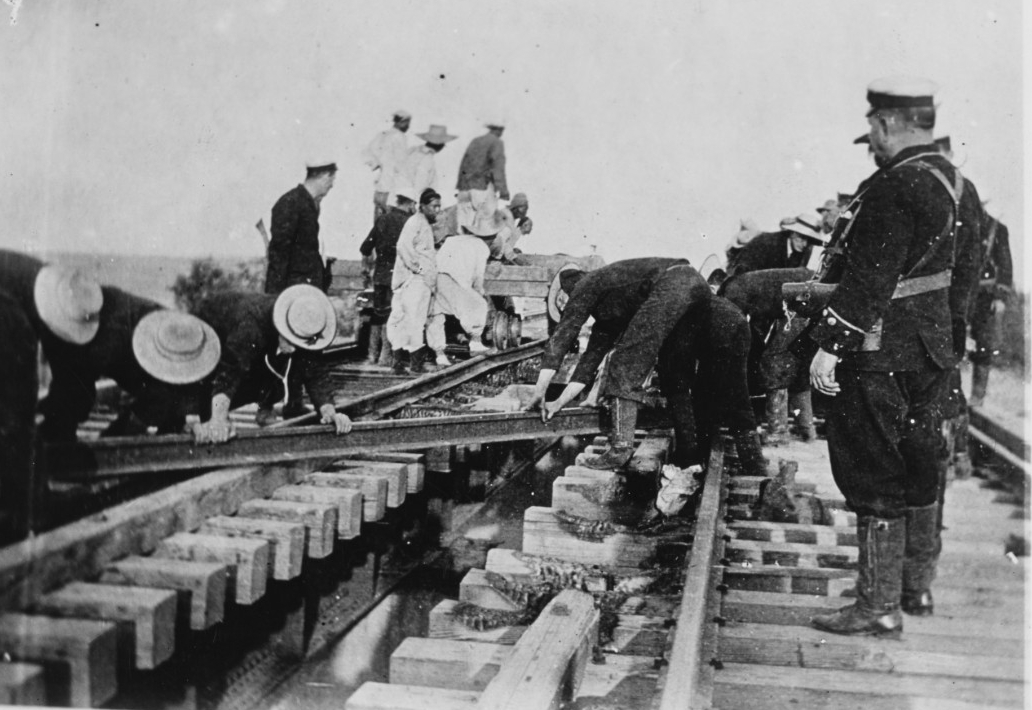
Sailors repair a destroyed railroad. (NHHC USN-901032.)
On 14 July, the Boxers caught the allied forces at Langfang by surprise. Their first victims were five Italians in the village’s orchard fields, who tried to run. But this time, the Boxers had abandoned their ritualistic approach in favor of speed. They had almost reached the train by the time the allies fired the first shots. Hand-to-hand combat ensued, with Captain McCalla shooting Boxers at close range. The Boxers advanced until the allies deployed a Gatling gun. Then, the Boxers fled, leaving 102 lying dead.[20]
One of the banners taken from a dead Boxer read, “Death to all foreigners: by order of the Government.” The allied forces believed the Boxers were lying about Qing government support in order to recruit. They continued on, burning every village that showed signs of a Boxer presence.[21]
On 15 June, Seymour sent his supply train to Tianjin, but the train returned with bad news: the railroad the allied forces had painstakingly repaired was in ruins. Low on supplies, Seymour ordered his forces to retreat to Yangcun (Yangtsun), where the railroad crossed the Hai River (Pei ho River).[22]
Taussig recorded his suspicions that the Qing imperial troops had had a hand in the railroad’s destruction.[23] His suspicion was confirmed on 18 June, when Boxers supported by imperial troops attacked several of Seymour’s trains, killing six and wounding 48. The Imperial Army was now officially backing the Boxers, a reaction to allied forces seizing the Dagu Forts on 17 June.
In Yangcun on 19 June, Admiral Seymour and his troops set out on foot along the Hai River, commandeering junks to carry the wounded and supplies. The river was low due to the drought, so the officers had to jettison heavy guns and equipment and tow the junks from shore. They encountered rifle fire from Boxers, who moved along the river from village to village. At one village, the allied forces heard a volley of hundreds of rifles—which turned out to be firecrackers.[24]
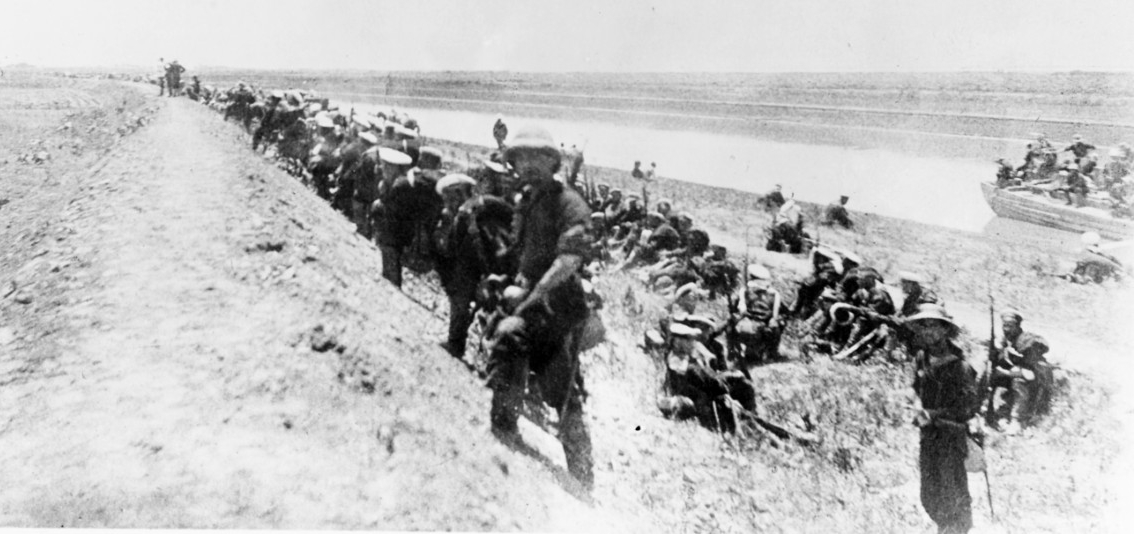
American and British contingents deployed behind an embankment of the Hai River and under fire from Chinese artillery during the Seymour Expedition retreat. British bluejackets are in the foreground, and the American detachment is in the background. The group standing on top of the embankment includes Admiral Edward Seymour, RN, and Captain Bowman McCalla, USN. The junk in the right foreground contains the wounded and supplies. (NHHC NH-2844.)
On 21 June, a Chinese cavalry unit began to shadow Seymour’s column. The next day, Seymour encountered Chinese troops in fortified positions along the river. Surrounded and under constant fire, Seymour and his troops made a daring nighttime march to sneak past the Chinese troops. Luck was on their side. The Chinese fired, but missed in the dark. Then, on 23 June, an even bigger stroke of luck: Seymour and his allied troops came upon the Xigu (Hsi-Ku) Arsenal, an enormous structure defended by only a small number of Chinese troops. They defeated the troops and discovered stores of food, arms, and ammunition. Now, the last order of business was to communicate with Tianjin.
A Chinese servant, Chao Yin-Ho, took on the heroic task. Chao swam the Hai River, then survived an interrogation by Boxers while tied to a tree and fire from French sentries when he arrived at the foreign enclave in Tianjin on 24 June. The next day, Chao led allied troops to the arsenal to escort Seymour and his men to Tianjin.[25]
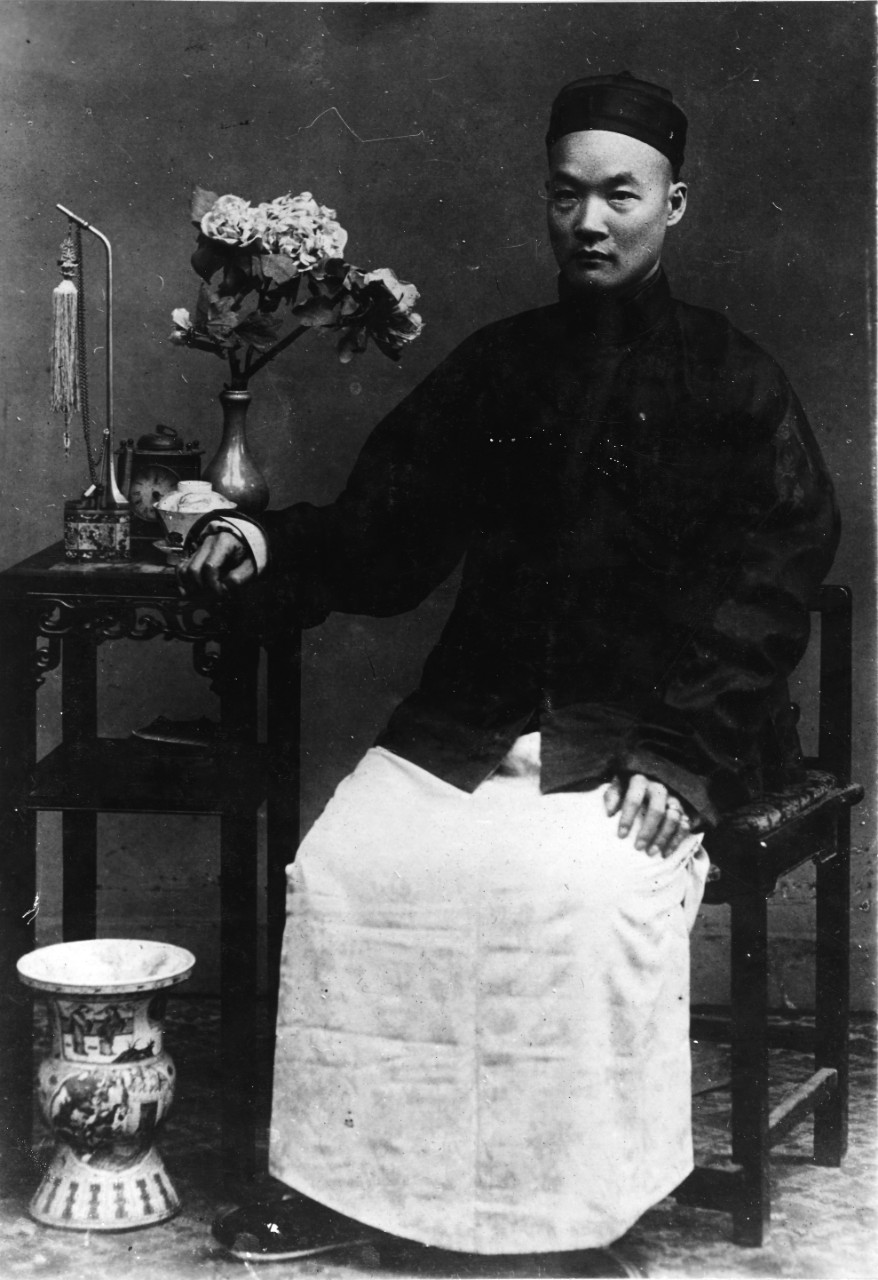
Chao Yin-Ho, the servant who carried a message across enemy lines to Tianjin. (NHHC NH-1400.)
Casualties for the so-called Seymour Expedition amounted to 62 killed and 232 wounded, with the Americans sustaining losses of 4 killed and 28 wounded—the highest casualties by percentage of any nation present.[26] Midshipman Joseph K. Taussig, who had been shot through the thigh, was carried from the Xigu Arsenal on a stretcher. Captain Bowman McCalla, who had been shot through the left instep and hip, rode into Tianjin on a donkey.[27]
Despite the expedition’s failure, Seymour lauded McCalla and the Americans in a letter to a senior U.S. naval officer at Dagu: “Their post was usually in the advanced guard, where their zeal and go was praised by all. I regret to state that Captain McCalla was wounded in three places, but considering the gallant way in which he exposed himself I am only equally surprised and thankful that he is alive.”[28]
Dagu Forts, 17 June 1900
The four Dagu (Taku) forts occupied a critical position at the mouth of the Hai River, which flowed to the city of Tianjin. As increasingly dire news filtered from Tianjin, and Rear Admiral James Bruce, RN, received reports the Chinese planned to send troops to the forts and mine the Hai River, he decided to take action. He met with the allied commanders off Dagu, and they agreed to send an ultimatum to the Chinese commander, demanding the Chinese surrender the forts to the allies by 0200 local time on 17 June.
The only commander not on board with the plan was Rear Admiral Louis Kempff, USN. Kempff had orders from Washington preventing him from acting unless the Chinese committed an act of war. Kempff’s contribution was to position the gunboat Monocacyin the Hai River and order Commander Frederick Wise to act if necessary. Given that Monocacy was likely to be attacked in its position, historians believe Kempff hoped the gunboat would join the fight.
According to allied reports, the Chinese began shelling the enemy ships about an hour before the 0200 deadline. Nine allied ships returned fire. Monocacy was in the middle of the action, and a six-inch shell crashed through the gunboat’s stern, then into and out of the hull without exploding. Rather than join the fight, Commander Wise moved Monocacy upriver to protect refugees onboard, a decision that resulted in criticism from Kempff.
British and Japanese troops captured the northwest fort. The northeast fort had been destroyed, and the two forts on the southern shore quickly surrendered. The battle of the Dagu Forts concluded by 0800, leaving the allied commanders victorious and the empress dowager furious.[29] She directed her anger at multiple targets: the Seymour Expedition and the foreigners in both Beijing’s Legation Quarter and Tianjin’s foreign concessions.
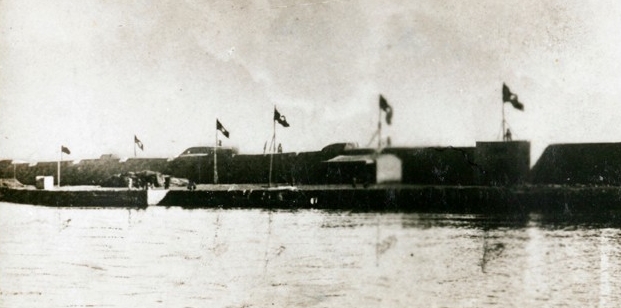
The Dagu Forts. (Jim Williams Collection and Special Collections, University of Bristol Library, www.hpcbristol.net/visual/jw-s29.)
Siege of the Legations, June–August 1900
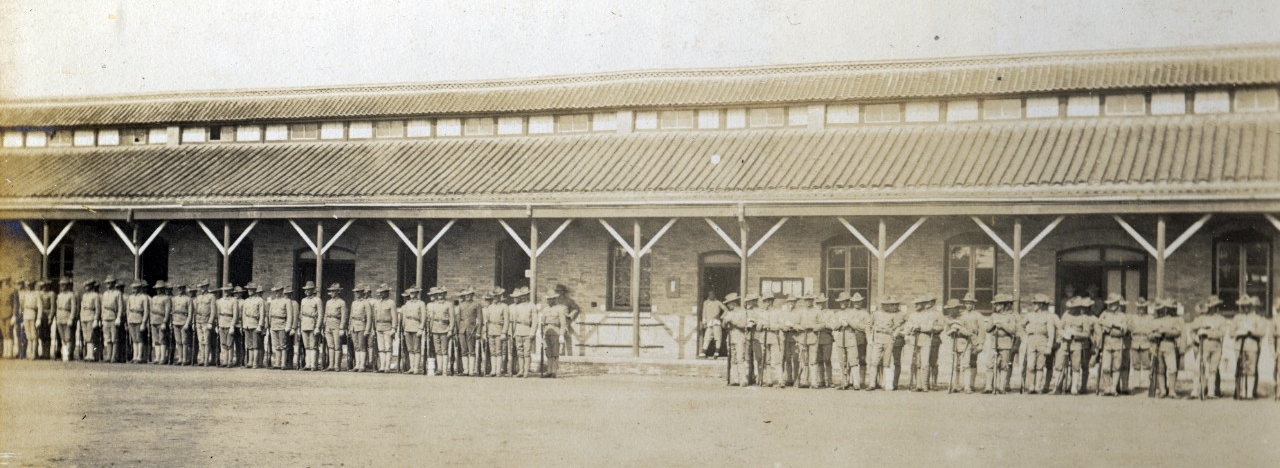
Marine guard outside the U.S. legation at Beijing. (NHHC.)
The first several days at the Legation Quarter were uneventful for Captain John T. Myers and his Marine detachments. But, on 6 June, when Boxers burned several railroad stations, Myers wired McCalla, requesting 25 additional men to protect the American legation. On 7 June, the British marine officer present, at Myers’ request, called a meeting of the officers at the legations to adopt a defense plan. They decided that in the event of an attack, all noncombatants and provisions would be sent to the British legation, streets leading to the legations would be barricaded, and Chinese people would not be allowed to enter without a pass. They also agreed to “endeavor to hold all the legations as long as possible, and as a last resort, to fall back upon the English legation.”[30]
On 11 June, Japanese chancellor Sugiyama Akira went to the train station to await the arrival of the ill-fated Seymour Expedition. The allied force never arrived, and Akira was murdered by Chinese troops.[31] On 13 June, two Boxers carrying swords arrived in the Legation Quarter followed by a large crowd. The German minister, Clemens von Ketteler, led German sentries in a chase after the Boxers. One Boxer was captured, the other escaped. When the large crowd gathered in front of the American legation, the Americans fired their Colt machine gun to drive away the Chinese.
That evening, Boxers set fire to the outside chapel of a Methodist mission. The mission lay three-quarters of a mile east of the Legation Quarter and housed American missionaries and Chinese Christian refugees. Minister Conger had displayed foresight by sending Corporal Martin Hunt, USMC, and 10 men to the mission on 8 June, followed by 10 more men under Captain Newt Hall on 9 June. Hall and his men drove the Chinese crowd back from the mission with bayonets, but the chapel had been destroyed. Back in the Legation Quarter, the allies cleared the streets and built barricades. That night, Boxers burned outlying missions and churches in Beijing, sparing only the Beitang (Peitang) Cathedral, guarded by French and Italian marines, who would defend the church and its Catholic priests and nuns until 15 August, when they were rescued by Japanese troops.
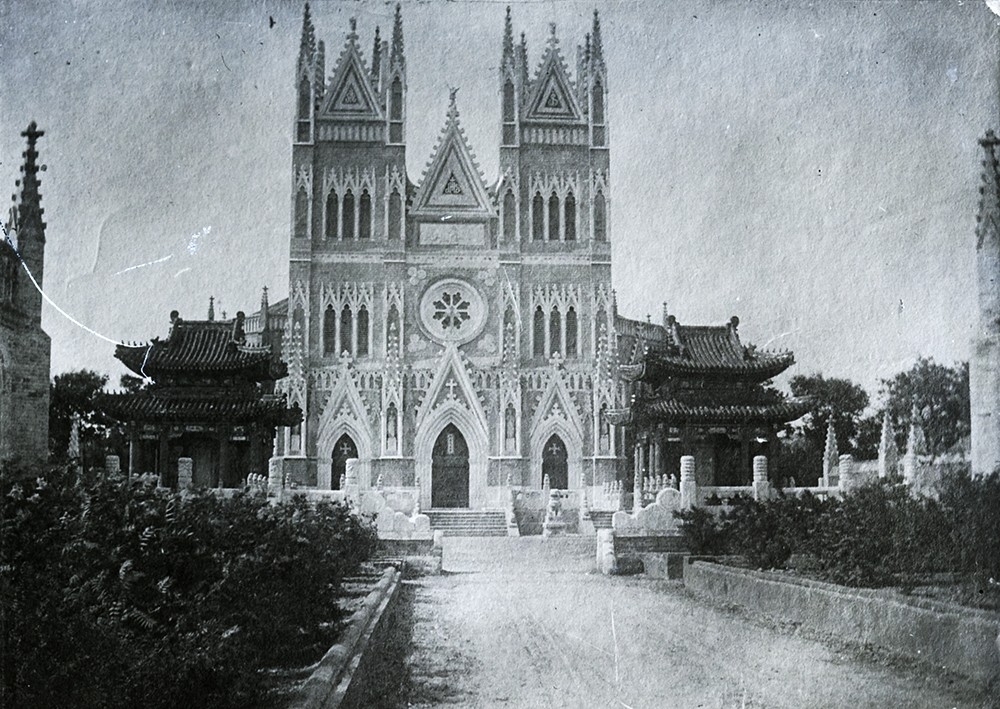
The Beitang Cathedral. (Billie Love Historical Collection and Special Collections, University of Bristol Library, www.hpcbristol.net/visual/bl-n090.)
The morning of 14 June, badly burned Chinese Christians appeared at the barricades to the Legation Quarter. They were allowed entrance, treated by American and Russian surgeons, and sent to the French legation. A Russian officer decided to send a search party to rescue Chinese Christians, and Myers supported the effort with a party of 10 Americans led by William Pethick, a veteran of the American Civil War, a Chinese linguist, and a scholar of Chinese literature. The rescuers returned to the Legation Quarter with about 150 Chinese Christians. That night, the allies inside the legations went to sleep to cries outside their barricades of “Sha! Sha!”—“Kill! Kill!”
On 15 June, a rescue party of British and American troops, including the surgeon Thomas M. Lippitt, failed to find more Chinese Christians, but came across a meeting of Boxers in a temple. The allies, bolstered by Japanese and Austrian troops, surrounded the temple and killed 45 Boxers.
The flames of the Boxer’s rage spread throughout the city. On 16 June, Boxers burned down Watson’s drug store in the southern part of the city, setting off a chemical explosion that tore through the richest part of Beijing. The following day, a Boxer started a fire only half a mile west of the legation barricades, which took the allies and municipal fire department two hours to put out.[32]
The day of 18 June spelled misfortune for the legation guard, just as it did for Seymour and his columns inching their way through the Chinese countryside. In retaliation for the allies’ capture of the Dagu Forts, the Zongli (Tsungli) Yamen, the Qing government body in charge of foreign policy, informed the ministers that a state of war existed, and that they had 24 hours to leave Beijing with protection guaranteed until they reached Tianjin.
The foreign ministers were skeptical of this offer for protection. The British minister MacDonald believed that once they left the safety of the Legation Quarter they would be slaughtered like the besieged Westerners at Cawnpore during the Indian Sepoy Rebellion.[33] Ultimately, the ministers agreed to cooperate with the empress dowager’s ultimatum, but requested a meeting with the Zongli Yamen on the morning of 20 June to discuss their safe passage. The morning came and, with it, no response from the Zongli Yamen. Impatient, the German minister von Ketteler set out with his interpreter to visit the offices of the Zongli Yamen, a decision that would alter the course of history. On the journey from the Legation Quarter to Chongwenmen (Hatamen) Street, an imperial soldier fired a fatal shot into the German minister’s back. Von Ketteler’s interpreter sustained a leg wound, but escaped and sought refuge at an American mission.
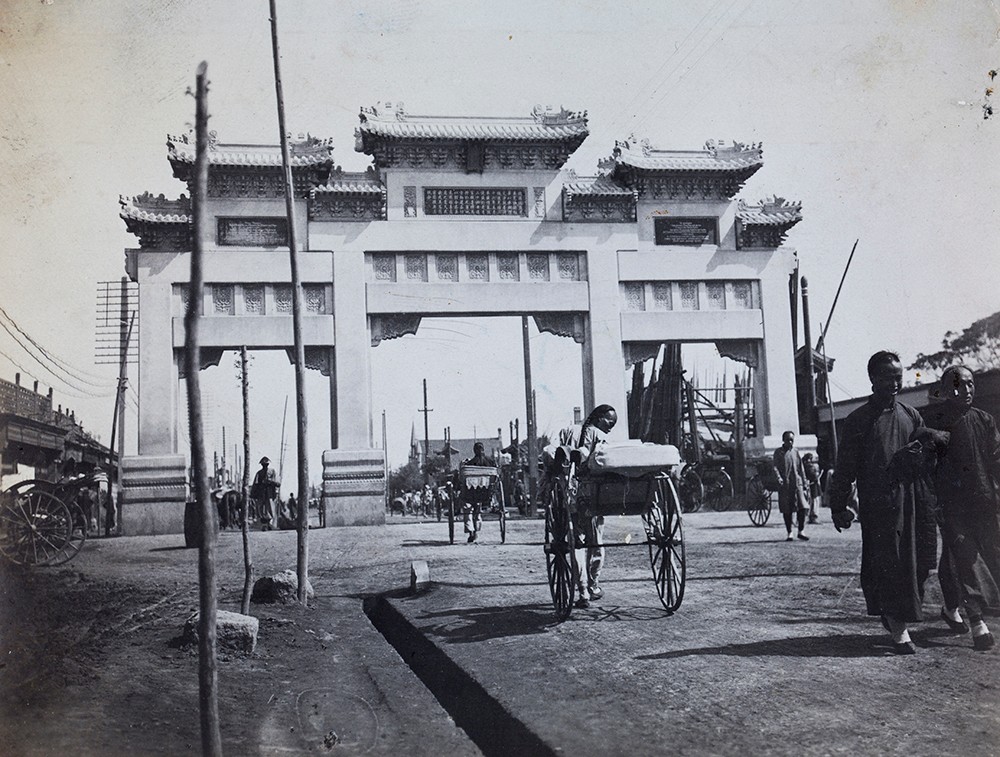
Monument for Baron von Ketteler erected by the Chinese government on the spot of his assassination as agreed upon in the Boxer Protocol of 1901. (Special Collections, University of Bristol Library, www.hpcbristol.net/visual/wc01-106.)
When the Germans learned of their fallen minister, they sent a detachment to recover his body, but gunfire forced them to return to the legations. A safe journey from Beijing to Tianjin was no longer an option. The allies resorted to their defense plan, sending women and children to the British legation, along with all food supplies and a guard of 10 men from each allied nation. Captain Myers led 15 Americans, 10 Russians, and 10 British troops to escort Captain Hall and his men, who had guarded the Methodist mission, into the relative safety of the legations. That evening, Chinese soldiers fired upon the allies and spies reported Boxers were entering the city and moving freely among the imperial troops. According to Captain Myers, “They appeared to be on the best of terms.”[34]
On 22 June, miscommunication may have led to misfortune. Almost all the legation guard retreated to the British legation under the orders of an Austrian captain. A report by G. E. Morison, the London Times correspondent at Beijing, blamed “an irresponsible American” who had told the Austrian captain that the American legation had been abandoned. [35] A firsthand account by British civilian Nigel Oliphant tells that the miscommunication prompted a meeting of the ministers, who chose Sir Claude MacDonald as commander of the legations. MacDonald then ordered the guards to retake their positions, but for the Italians and the Austrians it was too late.[36] Their legations were already burning. Oliphant’s account of 22 June conflicts with Captain John Myers’ report. While Myers recorded a “misunderstanding of orders,” he wrote that “the mistake being quickly discovered, our positions were at once reoccupied before the Chinese knew of our absence.” In Myers’ account, the meeting of ministers to appoint MacDonald occurred a day prior rather than in reaction to the miscommunication.[37]
One thing is certain: the legations were burning. As the Legation Quarter’s defenses went up in flames, the fate of the allies rested on their ability to defend the section of the 60-foot-high Tartar Wall overlooking the German and American legations. Otherwise, Chinese troops atop the wall could directly bombard the allies—which they did on 24 June. Myers tried to lead the Americans to occupy a position on the wall, but heavy smoke and Chinese gunfire hampered efforts. The next day, the Americans and Germans succeeded in seizing positions on the wall and building barricades. The Americans held the western part of the Tartar Wall, the Germans the eastern.[38]
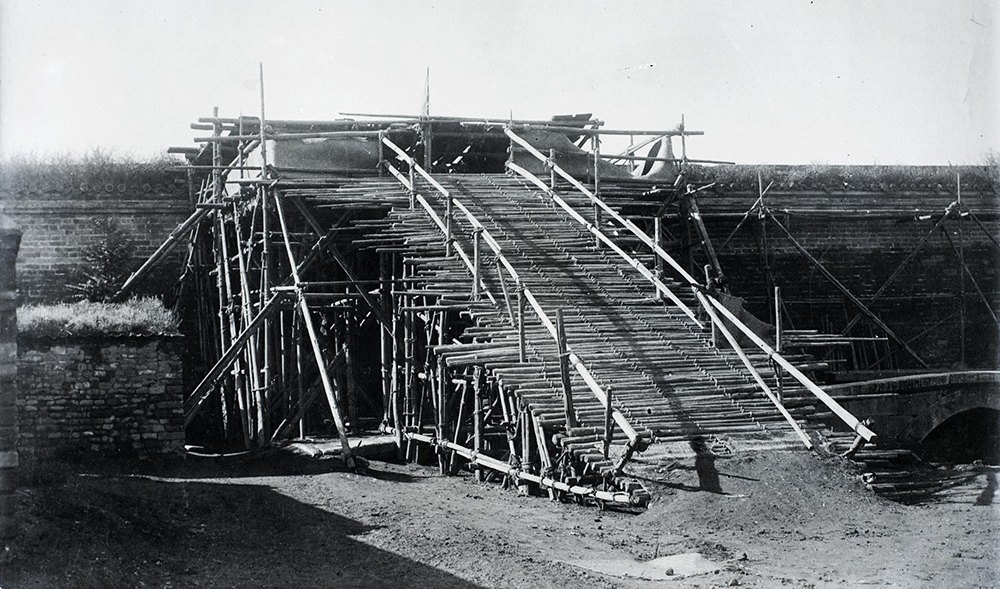
Chinese gun platform built from bamboo against the Tartar Wall overlooking the Legation Quarter. (Billie Love Historical Collection and Special Collections, University of Bristol Library, www.hpcbristol.net/visual/bl-n047.)
On 27 June, the Chinese troops atop the wall made a running advance toward the American position. The Americans drove them back with a few volleys, but over the next three days firing continued through the night, and the Chinese advanced their barricades to within 30 to 40 yards of the American position. On 1 July, heavy shellfire forced the Germans to abandon their position atop the Tartar Wall, leaving Myers and his men unguarded at the rear. Myers withdrew his men, but after conferring with Minister Conger and the American legation’s secretary, H. G. Squiers, retook the position no more than 15 minutes later. Luckily, the Chinese had not pressed their advantage in Myers’ absence. That evening, Sir Claude MacDonald ordered Myers to rest inside the legation—Myers had commanded the Marines atop the wall for five days straight with no sleep.
Captain Newt Hall relieved Myers atop the wall for about a day. When Myers retook command the evening of 2 July, he found the Americans in a far less favorable position than he had left them. On Hall’s watch, the Chinese had built a wall closer to the Marines’ position and were in the process of building a tower that would allow them to fire down onto the Americans. Myers reported the situation and, after a conference with the British and Russian ministers, Minister Conger ordered Myers to attempt to take the Chinese barricade.
Between 0200 and 0300 local time on 3 July, the Russians and British sent men to support the mission. By then, the Chinese had almost finished their tower and were daring to throw stones into the American barricade. Wasting no time, Myers ordered his men to advance. In a morale-boosting success that secured the wall and the legations, the allies drove the Chinese from their barricade and inflicted considerable losses, but also sustained several of their own. Myers reported that “two of the best men in the guard,” Privates A. Turner and J. Kennedy, were killed by gunfire. Captain Myers, too, was wounded by an “iron-pointed spear on the inner side and immediately below [the] right knee.”[39]
Captain Hall took command of the Marines from the wounded Myers, but would not formally relieve him until 21 July. On 12 June, Hall and his men began building a barricade about 100 yards away from the initial American barricade, but on 15 June, Squiers informed Hall the barricade was not far enough along the wall. Squiers wanted the barricade 100 yards farther from the one Hall had begun, only yards from the Chinese barricade.
At 0900, Captain Hall and Private Dan Daly walked along the wall to the desired position for the barricade. Provided the two Marines were not attacked, Chinese laborers were to arrive with sandbags 10 minutes later. The laborers never came. Private Daly volunteered to remain atop the wall while Hall went back for the laborers. Reluctantly, Hall agreed. Hall returned to the American barricade to find the delay was due to the Chinese laborers’ interpreter, who could not understand English. Alone, Daly defended his position under constant fire until the laborers and reinforcements arrived—an act of heroism that inspired Hall to recommend Daly for the Medal of Honor.[40]
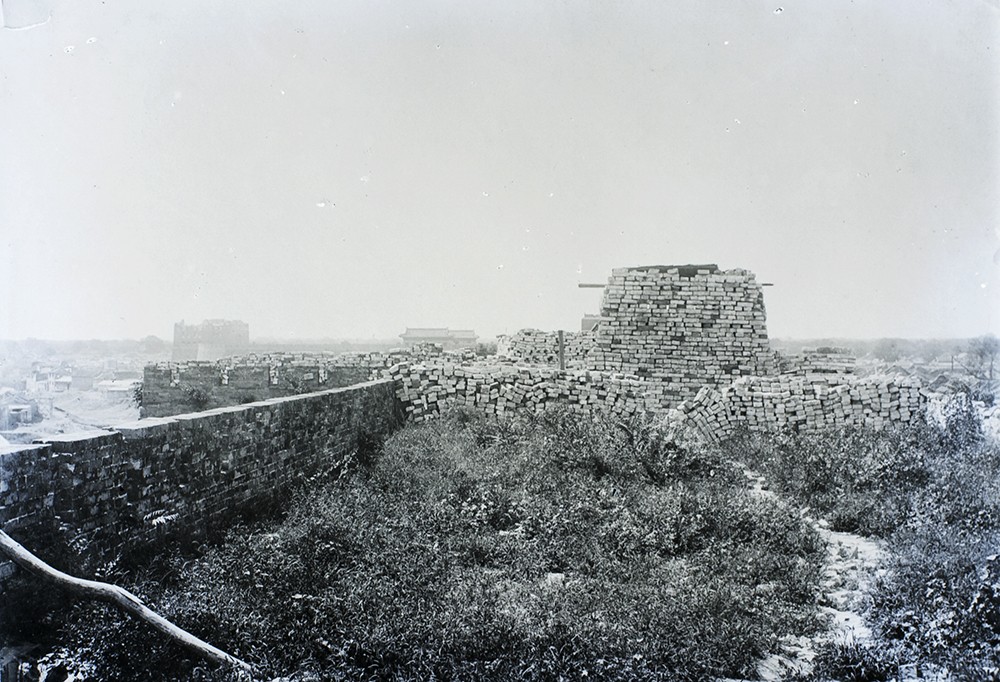
Chinese barricade atop a wall. (Billie Love Historical Collection and Special Collections, University of Bristol Library, www.hpcbristol.net/visual/bl-n006.)
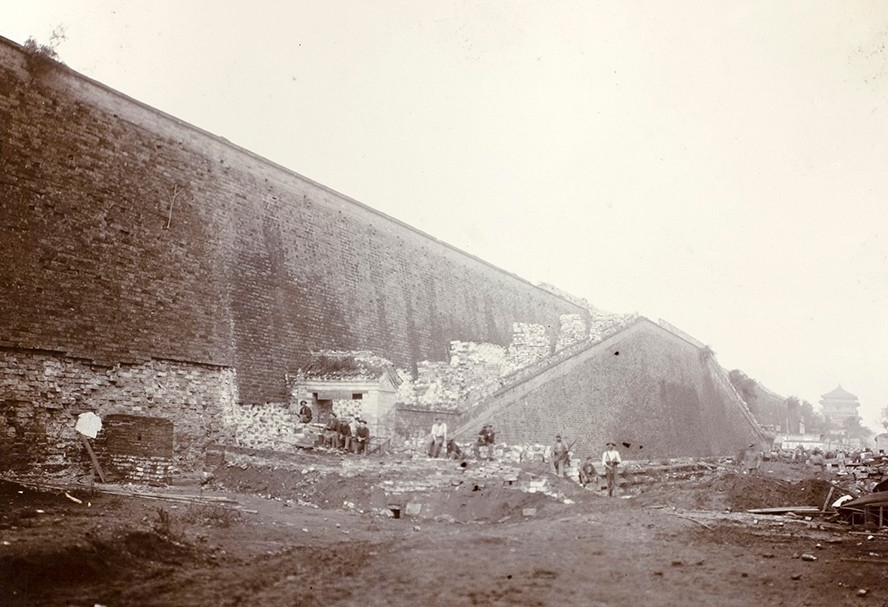
Wall fought over by the Americans and the Chinese. (The National Archives, London, UK, C0 1069/425, www.hpcbristol.net/visual/na05-26.)
Daly’s Medal of Honor citation, described by journalist Charley Roberts as a “masterpiece of understatement,” reads, “In the presence of the enemy during the Battle of Peking, China, 14 August 1900, Daly distinguished himself by meritorious conduct.”[41] Roberts notes that the date on the citation, 14 August, is when the international relief force arrived at Beijing, and “not necessarily the date of Daly’s heroic actions during the siege.”[42] Daly would earn a second Medal of Honor for once again fighting “with exceptional gallantry against heavy odds” in Haiti in 1915, making him one of only two Marines to earn the highest military award for two separate actions.[43]
Another Medal of Honor was awarded posthumously to Private Harry Fisher, who was killed at 0930 on 16 July while helping to erect a barricade under heavy fire and later buried in the Russian legation. Fisher was the first Marine to receive a Medal of Honor posthumously—except “Harry Fisher” was not his real name. On 6 March 1899, Franklin J. Phillips, a private in the 1st U.S. Infantry Regiment, had deserted from Camp A. G. Forse in Huntsville, Alabama, after being refused a sick furlough for the malaria he had caught serving in Cuba. Phillips asked to be restored to duty on 17 March 1899, but instead found himself with a dishonorable discharge for desertion. Two months later, Phillips joined the Marine Corps under the name “Harry Fisher.”
After Fisher’s death, his mother wrote to the Commandant of the Marine Corps requesting the Marine Corps rolls be corrected with her son’s true name. Her request was denied, and she accepted Phillip’s Medal of Honor under his alias. It wasn’t until 1988, after requests from congressmen, that the Commandant of the Marine Corps requested records at Headquarters Marine Corps and the National Archives be changed to reflect Phillip’s name. Also in 1988, a maritime prepositioning ship named MV Private Harry Fisher was renamed MV Private Franklin J. Phillips.[44]
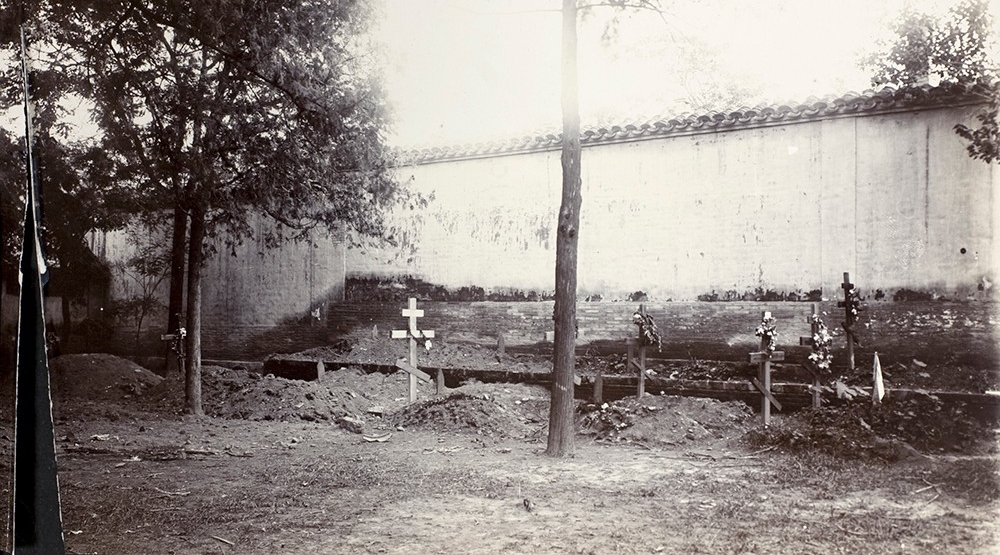
Graveyard in the Russian Legation where Russian soliders and American Marines, including Private Franklin J. Phillips, were buried. (The National Archives, London, UK, C0 1069/425, www.hpcbristol.net/visual/na05-19.)
The day of Fisher’s death, an uneasy peace came to the Legation Quarter. This “half armistice” was the result of a correspondence between Sir Claude MacDonald and Prince Qing (Ching), the leader of the moderate Chinese faction. The pro-Western Qing had served as head minister of the Zongli Yamen until 10 June, when General Nie’s telegram had alerted Empress Dowager Cixi to the Seymour Expedition. In swift fashion, Cixi had replaced Qing with the leader of the court’s conservative faction, the pro-Boxer Prince Duan (Tuan).
MacDonald suggested a cease-fire, and the Chinese agreed, allowing the allies to establish contact with the world outside the Tartar Wall. A messenger of the Japanese colonel Shiba Goro brought word that the allies had captured the walled city of Tianjin and would soon march for Beijing. [45] Promising news, but the weary foreigners inside the legation still had a long wait ahead.
Of the two Marine detachments from Oregon and Newark, seven were killed and 10 wounded before the legations could be relieved. Among the wounded was the assistant surgeon, Thomas Lippitt, who was shot in the leg while walking in the courtyard of the American legation on 29 June. His role was filled by American missionary George Lowry.[46]
Daly and Fisher were not the only servicemen to earn a Medal of Honor for valor displayed during the siege of Beijing. Among the U.S. Navy recipients were Hospital Apprentice Robert H. Stanley, who braved a street rife with Chinese gunfire to carry a message to the British legation and Gunner’s Mate Joseph Mitchell of Newark, who not only operated the American’s Colt gun under heavy fire but also constructed and manned an improvised canon.[47] Nicknamed the “International Gun,” the canon was comprised of an English barrel secured to an Italian gun carriage with Chinese rope and fired Russian shells filled with German powder ignited by a Japanese fuse. The canon’s other nicknames included “Old Betsy,” “Boxer Bill,” “Old Crock,” and the “Empress Dowager.”[48]
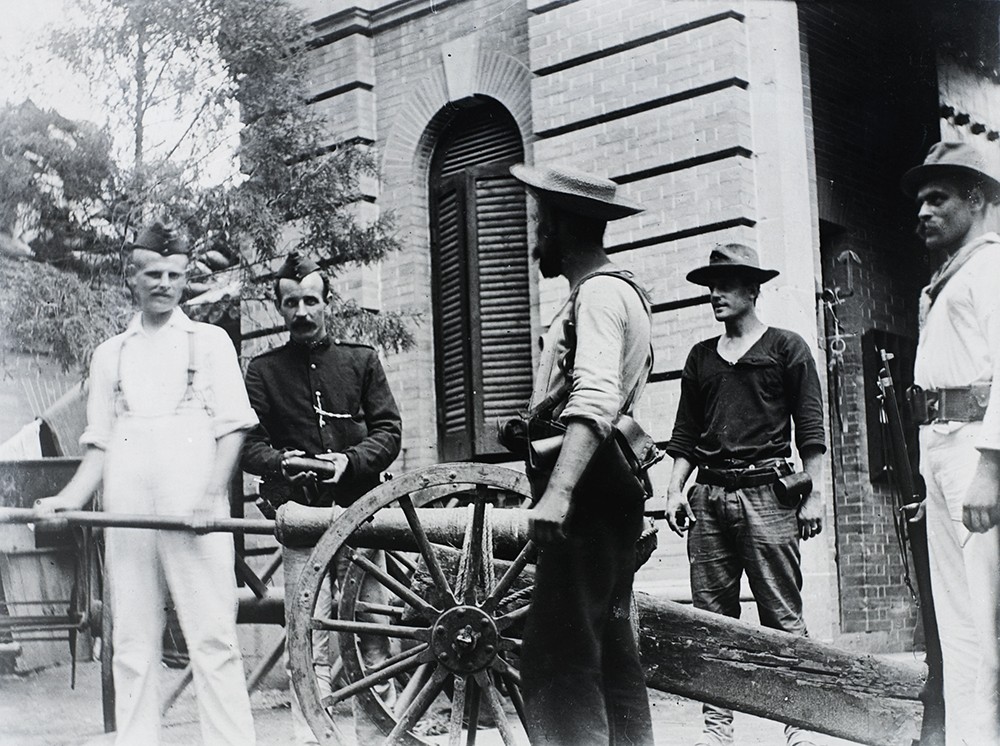
The “International Gun” and its crew. Medal of Honor recipient Gunner’s Mate Joseph Mitchell stands second from the right. (Billie Love Historical Collection and Special Collections, University of Bristol Library, www.hpcbristol.net/visual/bl-n033.)
Additional Marine Corps recipients of the Medal of Honor included Sergeant Edward Walker, Corporal Martin Hunt, and Corporal John O. Dahlgren, all who, according to Myers, “cheerfully performed their duties with courage and fidelity.”[49]
“The conduct of the guard,” Myers wrote, “with one or two exceptions, was excellent.”[50]
Battle of Tianjin, June–July 1900
Tianjin (Tientsin) was a major trading city connecting the coast to the capital city of Beijing (Peking) and could be reached by rail or by sea. Foreign powers maintained concessions to the southeast of the walled city, each with schools, hospitals, and barracks. For the 600 foreigners and 4,000 Chinese Christians living in Tianjin’s foreign concessions, the situation mirrored that of those in the Legation Quarter at Beijing.[51] In mid-June, Boxer violence in Tianjin escalated, with Boxers killing Chinese Christians, setting fire to foreign shops and churches, and attacking the concessions.
The allies responded to reports of Boxer violence by capturing the Dagu Forts at the mouth of the Hai River, which flowed to Tianjin. Just as for the Seymour Expedition and the Beijing Legation Quarter, this action exacerbated the situation in Tianjin. The Chinese shelled the concessions from the walled city and from their West Arsenal. The Boxers tore through the French quarter and attacked the rail station, where Russian troops held them off, but suffered about 100 casualties. As pressure mounted from the growing presence of Boxers and imperial troops at Tianjin, allies sent messengers to Dagu requesting immediate relief.
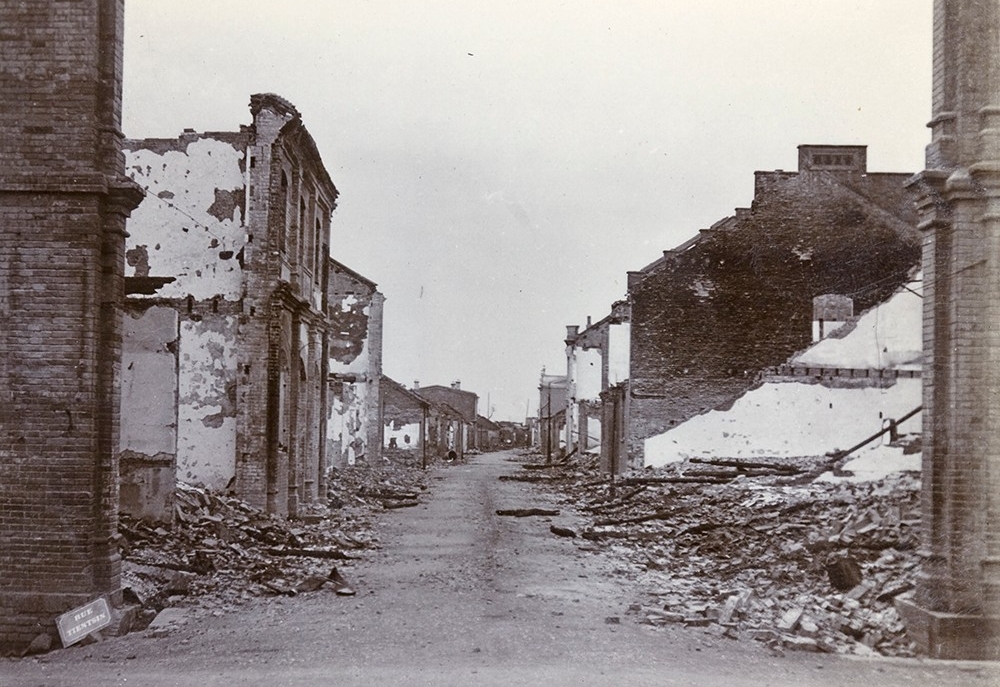
Ruins of Rue de Tianjin, a street in the French concession. (The National Archives, London, UK, C0 1069/422, www.hpcbristol.net/visual/na02-45.)
Initial Attack, 21 June 1900
On 18 June, the U.S. War Department ordered General Arthur MacArthur in Manila, Philippines, to send troops to Dagu. The 9th Infantry Regiment, commanded by Colonel Emerson H. Liscum, prepared to depart, but a typhoon delayed their leaving until 27 June. Luckily for the foreigners in Tianjin, the U.S. Marines reacted faster. On 14 June, six officers and 101 enlisted Marines from the 1st Regiment left Cavite on Solace and arrived off Dagu on 18 June. There, they joined a detachment of two officers and 30 enlisted Marines from Nashville. Major Littleton W. T. Waller commanded the combined force, which was armed with a 3-inch field piece and a Colt machine gun.[52]
The Marine force disembarked on 19 June and advanced to Tanggu (Tongku) on the morning of 20 June. At Tanggu, they commandeered a train and, with the help of Navy machinist’s mates and water tenders from Monocacy, resuscitated its engine and departed for Tianjin, repairing the railroad as they went. Twelve miles from Tianjin, the railroad tracks were impassable. Major Waller and his Marines abandoned the train and joined with a force of about 400 Russians. Waller and the Russian commander agreed to bivouac for the night and hold their position until reinforcements arrived, but at 0200 the Russian commander informed Waller of his intent to push on for Tianjin.[53] Waller objected, believing 530 men inadequate to pass the Chinese force. Later, Waller wrote in his report that he was “overruled in council,” though, with the exception of Rear Admiral Louis Kempff, no one trumped him in authority.[54] Still, the Marines joined the Russians in the early morning advance.
The Marine’s 3-inch field piece proved defective, so Waller had it hidden in a canal. The column advanced along the rail line, with U.S. Marines and the machine gun at the front under the command of First Lieutenant W. G. Powell, followed by the Russians, and the rest of the U.S. Marines at the rear. The allied column advanced undisturbed until 0700, when it reached an imperial arsenal, from which the Chinese opened fire to the right of the column. This fire was light and silenced by Marine sharpshooters. But then an estimated 1,500 to 2,000 Qing imperial troops opened up heavy frontal and flanking fire. The Marine’s Colt machine gun responded to the frontal fire, which came from hidden trenches, while Marines and Russians opened fire on the right. Boxers “annoyed” the Marines to the left but were driven off. The allies held their position until the Russians fell back, exposing the Marine’s left flank. Then, the Colt gun jammed, and all but one of its small crew were killed or wounded. Abandoning the Colt, Waller and the Marines withdrew under fire, bringing up the rear and fending off imperial troops and Boxers for four hours before reaching safety at 1400 local time. The Marines had marched for 30 miles, fought for five hours, and lost four killed and nine wounded.[55]
Waller’s report of the action on 21 June was pessimistic: “We are footsore and weary, but will go forward now. The condition at Tientsin is almost hopeless. If we can not attack tomorrow, I fear the worst.”[56]
Relief of the Foreign Concessions, Capture of the East Arsenal, 21–27 June
At 1700 on 21 June, the reinforcements Waller had wanted to wait for arrived. All together, the allies numbered about 2,000, half of which were Russian and the rest British, German, American, Italian, and Japanese, in descending order of troop numbers. Waller wrote that he had “decided to act in cooperation with the British, under Commander Craddock”—seemingly a decision based on the failure of his alliance with the Russians the day before.[57] That night, Waller sent 16 Marines to join the British on a reconnaissance mission.
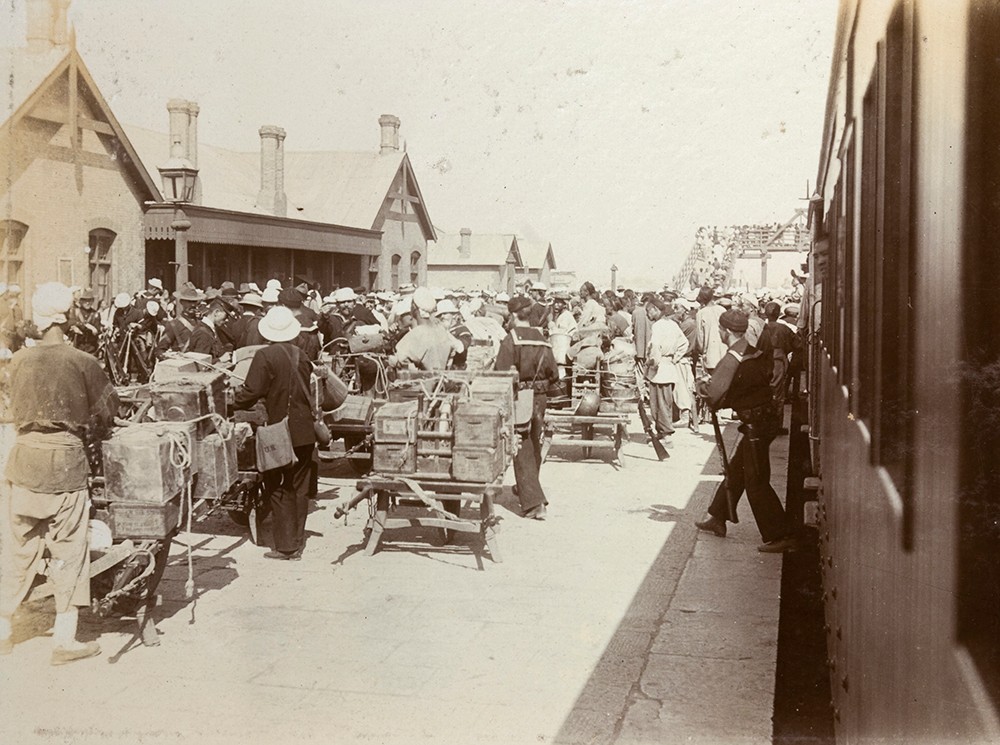
American forces arriving at the Tianjin railroad station. (The National Archives, London, UK, C0 1069/424, www.hpcbristol.net/visual/na04-53.)
The next day, the allies moved toward Tianjin and made camp for the night. Their plan: march on the city that morning in two columns, with the Americans and British on the left and the Germans and Russians on the right.
The allies set out at 0400 on 23 June. At 0700, they encountered the Chinese and advanced steadily. For eight to nine miles, the allies marched under fire, but the Chinese shot high. About 1,500 yards from the city, Private James J. Sullivan described fixing bayonets and charging the Chinese attackers, who fled. Then, the allies encountered a large fort and heavy fire. They fought for over an hour before sheltering in a trench. In the distance, they saw an English and a Russian flag. Then, an American flag was raised. It was the besieged concessions.
At 1230, the allies entered the Tianjin concessions to “shouting and cheering and crying and weeping for joy.”[58] The Americans were the first to enter the concessions and were each treated to a bottle of beer. Among the American civilians inside the concessions were future president Herbert Hoover and future first lady Lou Hoover. President Hoover later recalled, “I do not remember a more satisfying musical performance than the bugles of the American Marines entering the settlement playing ‘There’ll Be a Hot Time in the Old Town Tonight.’”[59]![]()
On 24 June, a visitor arrived at Tianjin: Chao Yin-ho, who brought word of Seymour and his force sheltered in the Xigu Arsenal and surrounded by imperial troops and Boxers. Feet swollen from marching about 50 miles, the allies rested for a day before setting out on 25 June with a force of 1,900 men. The Chinese fired as the allies crossed a river, but the bullets went high and all men made it across alive. Closer to the arsenal, the allies encountered the Chinese, and after 15 minutes had driven them away.
The return from the arsenal on 26 June was slow on account of the sick and wounded. However, it was also uneventful, as the Chinese did not dare to attack the allied force now numbering about 4,000. Cheers greeted the allies upon their return to Tianjin.[60] The wounded Captain McCalla, riding his donkey, left Waller in charge of the combined force of American seamen and Marines.
On 27 June, the Russians attacked the East Arsenal. When they requested reinforcements, Waller sent Second Lieutenant Wade L. Jolly with 40 Marines, entrusting the Americans to the Royal Navy commander Craddock. The allies were about 1,800 strong, and Waller estimated they were facing a force of 7,000 Chinese. Still, they succeeded in driving the Chinese from the arsenal. The Americans along with the British led the allies in a charge over the parapets, sustaining a loss of only one wounded. Lieutenant Jolly was “overcome with heat, but not until after he had brought his men back to their quarters.” Lieutenant A. E. Harding captured a Qing imperial flag and presented it to Waller.
Waller reported his men had marched 97 miles in a span of five days, living on one meal a day. “They have made history, marked with blood, if you please, still glorious and brilliant,” Waller wrote of his men. “They were the first in the field, and, please God, they will remain until the last man, woman and child is relieved from the toils of these barbarians.”
However, he had criticisms for the recipients of his report. The Marine’s uniforms were comprised of trousers that “last about two days” and blue shirts that “make a splendid target.” And, after the initial operations at Tianjin, his force was 89 troops, “disgracefully small” when faced with what lay ahead.[61]
Assault on the Walled City Delayed, Capture of the West Arsenal, 2–9 July
The allies may have relieved the foreign concessions, but the walled city of Tianjin and the West Arsenal were still held by Boxers and Chinese soldiers, who made a habit of shelling and attacking the foreign concessions. Civilians in the concessions lived in fear and sheltered inside cellars. The allies could not march for the besieged legations in Beijing until they had taken Tianjin, which would provide a logistical base in the interior of China.
When on 2 July the allies caught wind of 10,000 imperial troops under General Ma San Yuen marching for Tianjin, Major Waller insisted the city should be taken before the Chinese arrived. A meeting of military commanders initially decided to lead an attack on the morning of 3 July, but the Russian general was not ready to move on the city. The commanders settled on the morning of 4 July, but abandoned the attack when the imperial troops arrived early, on the evening of 2 July. Though Waller described the relations between the foreign powers as “outwardly friendly,” he noted that the Russians “delayed for two days the capture of Tientsin, and my prediction has come true.”[62]
Skirmishes kept the allies busy in early July, with the Chinese attacking the foreign-held railroad station in the hopes of cutting off communication. On 3 July, 80 Marines under Lieutenant Smedley Butler joined the Weihai (Wei hei wei) regiment under British colonel Hamilton Bower to capture a Chinese gun. The Weihai regiment was comprised of enlisted Chinese soldiers from Weihai, a city in Shandong Provide leased by the British in 1898. The allies failed to take the enemy gun but engaged in hand-to-hand combat to capture two villages. When heavy fire pinned down the Weihai regiment, Butler led the Marines in an advance that allowed the Weihai to retreat, then ordered the Marines to fall back by sections without any causalities. Colonel Bower sent his thanks to the Marines, expressing admiration for their training and discipline.
On 9 July, a joint force of British, Japanese, and Americans under Japanese major general Fukushima Yasumasa launched an attack against the Chinese, supported by a separate force of Russians—who had refused the command of a Japanese officer. Major Waller had predicted the Russian’s refusal in a report on 7 July, noting his willingness to serve under a Japanese field marshal given the need for “a common head for the military operations,” but that he “did not think the Russians or French would so agree.”[63]![]()
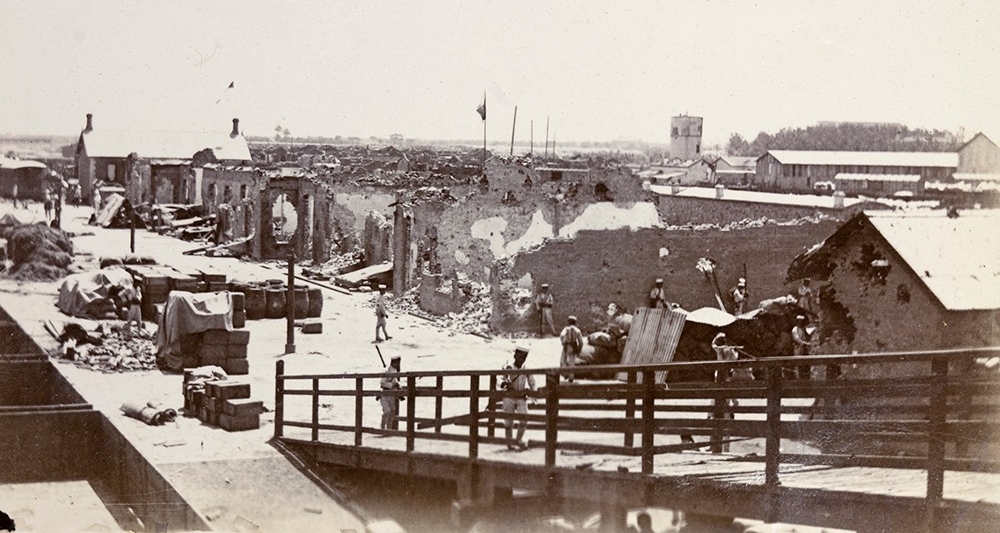
Ruins of the foreign-held railroad station at Tianjin. (The National Archives, London, UK, C0 1069/422, www.hpcbristol.net/visual/na02-19.)
The allies attacked to the west, where the Chinese threatened to cut off allied communication along the Hai River. They drove the Chinese back into a mud fort, silenced by the British and Japanese, and into the West Arsenal. Major Waller’s column, which included the U.S. Marines and Japanese sailors, charged for the arsenal, but met heavy fire. The Marines lay atop the roofs of huts to clear the plain in front of the arsenal. Waller then ordered his men along a mud wall, where they could protect the canal bridge from the main road to the arsenal. By covering the bridge, the Marines allowed the wounded, the Japanese and British batteries, and the Japanese, British, and Indian infantries to cross without sustaining any casualties.[64] Afterward, Waller received letters of thanks from Major General Fukushima and Vice Admiral Seymour. The allies captured the arsenal, a victory made less sweet because the structure was so destroyed it would be useless as a stronghold for taking the walled city.
Attack on the Walled City, 13–14 July
On 12 July, Colonel Robert Meade, USMC, arrived in Tianjin with a detachment of 318 Marines from Brooklyn. Colonel Emerson Liscum and the 9th Infantry arrived on 13 July. Waller had requested to stay in command of the Marines because he was “in touch with the situation and in splendid condition physically for the enormous amount of work to be done.”[65] However, seniority won out and Meade took command of the American forces upon his arrival.
The council of senior officers decided to take Tianjin on 13 July. Colonel Meade provided 1,000 men for the effort, 333 from Meade’s 1st Marine Regiment, 667 from the 9th Infantry. In total, 6,000 allied troops would face a force of about 20,000 Chinese troops (by Admiral Seymour’s estimation) and an indeterminate number of Boxers.[66] Two columns, one of the British and Americans under the British brigadier general A.R.F Dorward, and another of the Japanese and French, would attack Tianjin from the south. Meanwhile, the Russians and Germans would attack from the east.
The southward-attacking columns marched from the foreign concessions around 0300. The Royal Welch Fusiliers headed the American and British column, followed by Colonel Mead and Marine companies A, C, D, and F. These were commanded by Lieutenant Smedley Butler, Captain C. G. Long, Captain A. R. Davis, and Captain B. H. Fuller, respectively. Company F under Fuller was armed with three 3-inch rapid-fire guns and three Colt machine guns. After the Marines came the English naval brigade and then the U.S. 9th Infantry Regiment led by Colonel Liscum.
A mud wall ran around the perimeter of outer Tianjin, and another wall surrounded the inner city. The columns were under orders to march parallel to the outer mud wall and convene about 1,000 yards from the bridge at Tianjin’s south gate for a commanding officer’s meeting, but no meeting occurred. All decisions would be made in the heat of battle.
Meade ordered two Marine infantry companies, A and C, to advance along the wall while the artillery-equipped Company F and its infantry support, Company D, acted with the British artillery to fire on mounted Chinese guns. At 0500, companies A and C arrived at the mud wall’s gate, but fire from the West Arsenal prevented further progress.
At 0545, shellfire from the naval battery of HMS Terrible exploded the Chinese magazine “with a shock which was almost like an earthquake shock,” and the allies took the ruined structure.[67]
At 0630, Brigadier General Dorward ordered Meade’s companies A and C to support the Royal Welch Fusiliers on the extreme left of the allied lines. The Marines and Fusiliers crossed the canal and Tianjin’s mud wall and entered the outer city. There, they encountered flat, swampy ground with “grave mounds and dikes and ditches.” The mounds and dikes provided some cover, but casualties mounted in the face of accurate fire.
Meade’s Marines then made rushing advances to trenches within 800 yards of the inner city walls. There, the Marines and Fusiliers found “very bad swamps and a stream of water” that prevented further progress.[68]
For 12 hours—from 0800 to 2000—the Marines held their position armed with 180 rounds per man. Chinese imperial troops fired down from the walls and Boxers sniped from positions in the city’s suburbs.[69] Twice, attackers approached from the Marine’s left flank. The first time, Marines in the trenches drove them away. The second time, Company D fired on the attackers from the mud wall. As nighttime neared, Meade feared the possibility that ammunition would run out, leaving the Marines with only bayonets to fight. Finally, General Dorward gave the order to withdraw. Under constant fire, the Marines withdrew in small parties of 8 to 10 men “by rushes from mound to mound and trench to trench.” They reached a safe position near the mud wall’s south gate, with only one man hit during the withdrawal. There, the troops slept with their weapons.
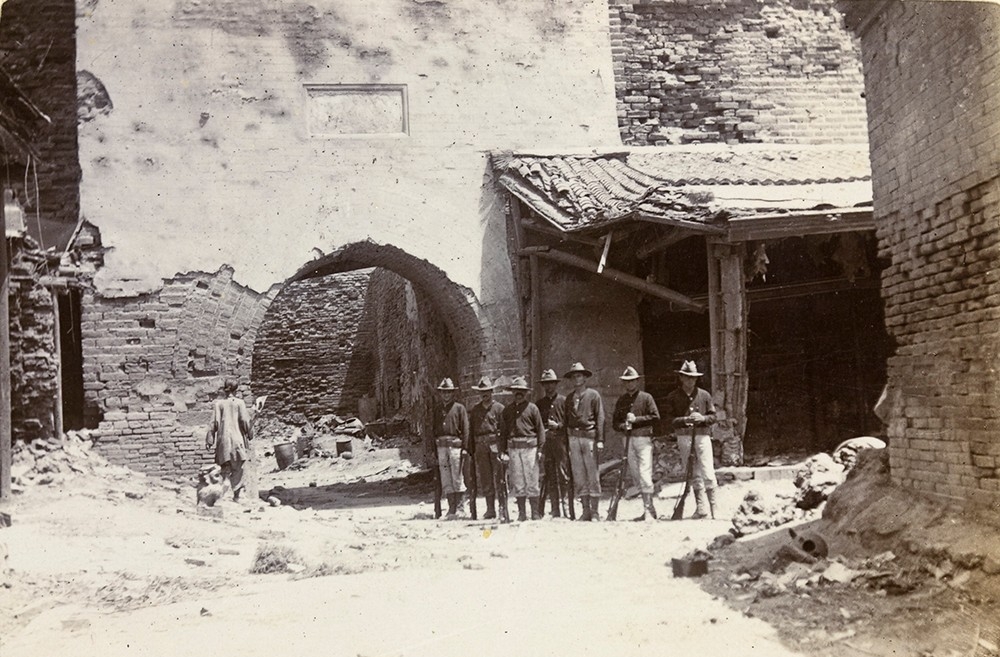
South gate of Tianjin held by the Americans. (The National Archives, London, UK, C0 1069/422, www.hpcbristol.net/visual/na02-23.)
Five Marines were killed on 13 July, including Captain Austin R. Davis, commander of Company C, who died at Meade’s side while fighting in the advanced trench. Casualties also included seven seriously wounded and 16 wounded. Meade commended Lieutenant Smedley Butler, commander of Company A, who left the trenches to rescue a wounded man and was shot in the thigh, as well as First Lieutenant Henry Leonard, who brought the wounded Butler to safety and in doing so was seriously wounded.[70]
The Marines may have endured a grueling fight in swampy trenches, but their losses paled in comparison to those of the 9th Infantry Regiment. Outside the West Arsenal, the regiment had deployed in a single line behind the other forces. Chinese fire flew high, passing over troops nearer to the mud wall and falling among the 9th. Within a half hour, the regiment had sustained nine casualties.
General Dorward sent a staff officer with orders that the 9th advance to the relative safety of the mud wall, then move to the left of the Japanese. Liscum asked for further instructions, but received none. Closer to the mud wall’s gate, Liscum joined General Dorward, who said it did not matter whether the 9th went to the right or left. Thus, while the Marines went to the extreme left, the soldiers of the 9th found themselves on the extreme right, exposed to fire from mud houses to the east.
Liscum had no time to receive further orders. He decided to advance on the mud village over a field made nearly impassable by ditches, holes, and deadly fire. Liscum marched along an elevated road, which allowed him a view of his troops, but made him vulnerable. A pond stopped the regiment’s assault in its tracks, and shortly after, Liscum received a mortal wound while holding the national colors. The 9th Infantry Regiment could not advance or retreat until 2000, when troops from the British Naval Brigade and the U.S. Marines provided covering fire. At the end of 13 July, the regiment’s losses were 17 killed and 71 wounded.[71]
General Dorward later took responsibility for the 9th Infantry’s misfortune:
I blame myself for the mistake made in the taking up of their position by the Ninth Regiment, not remembering that troops wholly fresh to the scene of action and hurried forward in the excitement of attack were likely to lose their way. Still the position they took up and gallantly stuck to all day undoubtedly prevented a large body of the enemy from turning the right of the attack line and inflicting serious loss on the French and Japanese.[72]
Lieutenant Colonel Robert Leonhard, a retired Army officer and research analyst, argues Dorward’s suggestion that the regiment prevented an attack is “plainly ridiculous,” as the Chinese could not have crossed the flooded, ditch-riddled field just as the Americans had failed to. In Leonhard’s view, what befell the regiment was “simply a blunder—a costly one.”[73]
At the end of the day, none of the allied forces had made significant progress. Like the Marines, the Russians and Germans attacking from the east had scaled the mud wall, but made little headway into the city. The Japanese had tried and failed to blow up the south gate.
The allied forces rested for the night—except for the Japanese. Under the cover of darkness, a brave engineer rushed the south gate and lit tins of gun cotton (nitrocellulose), which blew up both the gate and the engineer. A Japanese unit then entered through the ruined gate, scaled the inner wall under fire, and held the inner gate until morning.[74]
The U.S. Marines moved into Tianjin at 0600 on 14 July, finding a city filled with dead Chinese people and dead animals. Boxers fired from the suburbs, but otherwise the allies met no resistance.
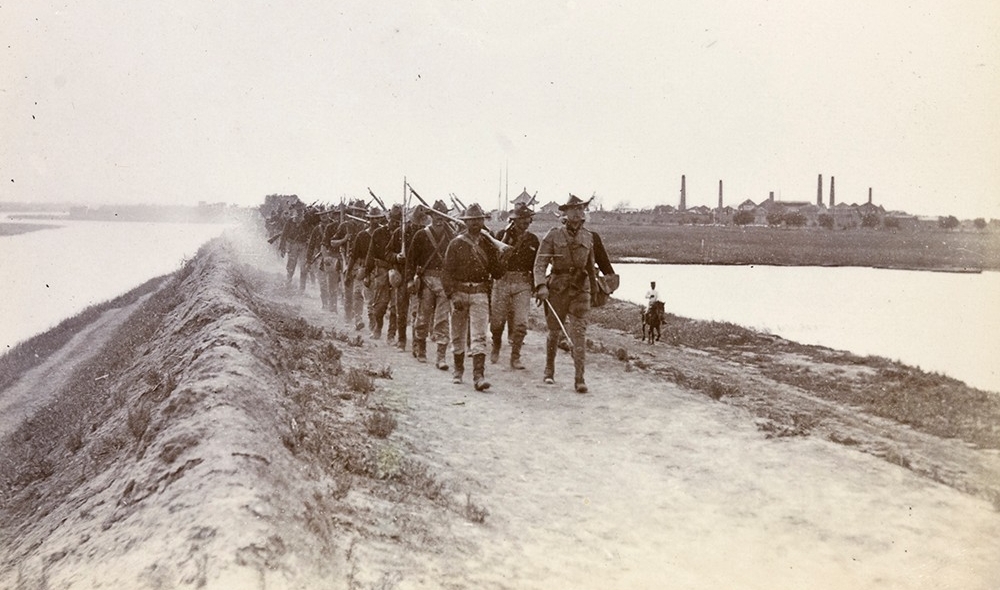
American infantry returning after the capture of Tianjin. (The National Archives, London, UK, C0 1069/422, www.hpcbristol.net/visual/na02-31.)
As Chinese civilians fled the city, allied troops looted it. The U.S. War Department wrote to the commander of the 9th Infantry, Lieutenant Colonel Charles Coolidge, asking if American troops had taken part in the spoils and demanding severe punishment. Coolidge denied reports of looting by Americans, but he had not been in Tianjin when the allied troops entered the city on 14 July.[75]
The treasury was looted and burned, but the Marines under Major Waller found its treasure—“silver bullion, fused with brick, mortar and other debris”—in the salt commissioner’s yamen (official residence). J.P. Morgan & Co. purchased the silver bullion for three bank drafts totaling $376,300 (roughly over $12 million today) made payable to the order of the Secretary of the Navy.[76]
In the face of unchecked looting, a representative from each of the eight powers present—Russia, Japan, Italy, Great Britain, France, Austria, Germany, and the United States—met to establish rules for a provisional government. Colonel Meade served as the American representative. The representatives decided a council of one Russian, one Japanese, and one Englishman would govern Tianjin. They also issued a proclamation to the city’s inhabitants:
In bombarding the city of Tientsin the allied forces only replied to the attack made by the rebels on the foreign settlements.
At present, as your authorities, forgetting their duties, have deserted their posts, the allied forces consider it their duty to establish in the city a temporary administration, which you all have to obey. This administration will protect everyone wishing to deal in a friendly manner with foreigners, but will punish without mercy everyone who causes trouble.
Let the bad people tremble, but the good people should feel reassured and quietly return to their houses and begin their usual work. Thus peace will be restored.[77]
Allied casualties for the Battle of Tianjin totaled 750 killed, wounded, and missing. The Japanese sustained the highest losses with 320 killed and wounded, followed by the Americans with 23 killed, 98 wounded, and one missing. Six Marines earned the Medal of Honor for actions on 13 July. Despite miscommunications, the allies had won a costly and critical victory. They had gained a foothold in the interior of China and could turn their attention toward a march to Beijing.
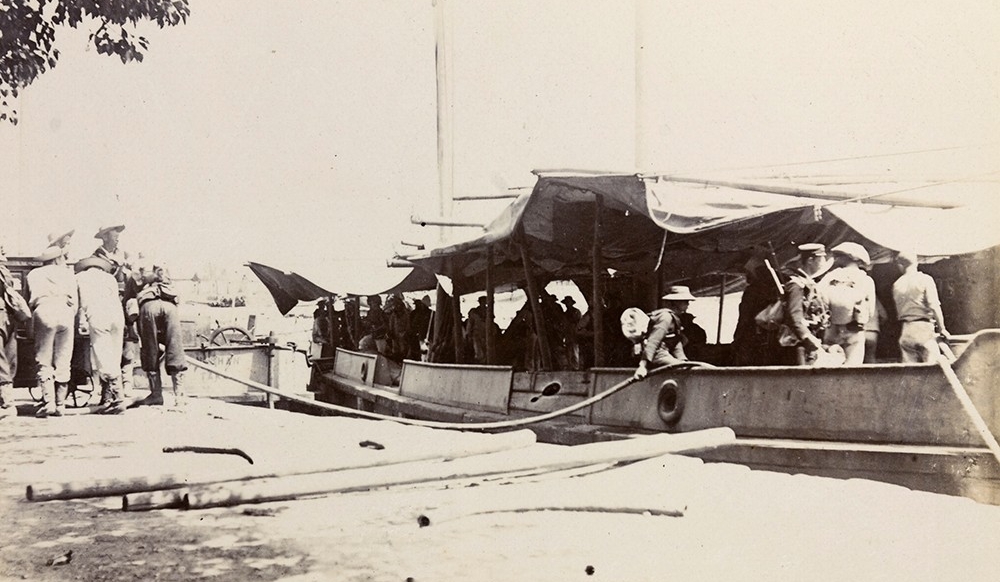
The first lighter to leave Tianjin with the wounded. (The National Archives, London, UK, C0 1069, www.hpcbristol.net/visual/na02-47.)
China Relief Expedition, August 1900
On 4 August, an allied force of just under 19,000 marched from Tianjin—less than half of the “40,000 seasoned troops, with not less than 25,000 in the attacking column” that Major Littleton Waller had assessed as the minimum force needed to take Beijing.[78]
British general Sir Alfred Gaselee and U.S. general Adna Chaffee had made the case for an immediate march on Beijing—a daring decision in light of the failed Seymour Expedition in June. General Gaselee was the acting commander of the relief expedition. The commander chosen by the allies—German field marshal Alfred von Waldersee—had not yet left Germany for China. General Chaffee had arrived in theater on 29 July after a meeting with Admiral Kempff aboard Newark.
The legations at Beijing could not hold out much longer, Gaselee insisted. The allies should strike while the Chinese were still reeling from their loss at Tianjin. On 21 July, Gaselee had received a letter from British minister Claude MacDonald that the legations had two weeks of provisions, but were eating their ponies. MacDonald’s message had taken two weeks to deliver. The messenger, a 16-year-old boy named Lin Wu Yuan, reported that the Hai River was in flood, crops were growing well, and fewer Boxers were on the roads.[79]
The French and Russians worried that in early August troops would face heat exhaustion or torrential rain. The Americans and British argued that with further delays, they would face a harsh winter and a frozen Hai River, a key supply line.
The allies may have also had motives beyond the weather. Leonhard has suggested that the Russians and French wanted to delay the march until their reinforcements arrived, giving them a “more dominant political position” when the allies took Beijing. Meanwhile, historian David Silbey has pointed out that Gaselee may have wanted to march for Beijing before von Waldersee could arrive in theater.[80]
The force that departed Tianjin on 4 August included 8,000 Japanese, 4,800 Russians, 3,000 British, 2,100 Americans, and 500 French. Under General Chaffee, the American troops were comprised of the 14th Infantry Regiment under Colonel A. S. Daggett, elements of the 9th Infantry Regiment under Colonel Charles Coolidge, Captain Henry J. Reilly’s Light Battery F of the 5th Artillery, a troop from the 6th Cavalry, and two battalions of Marines.[81]
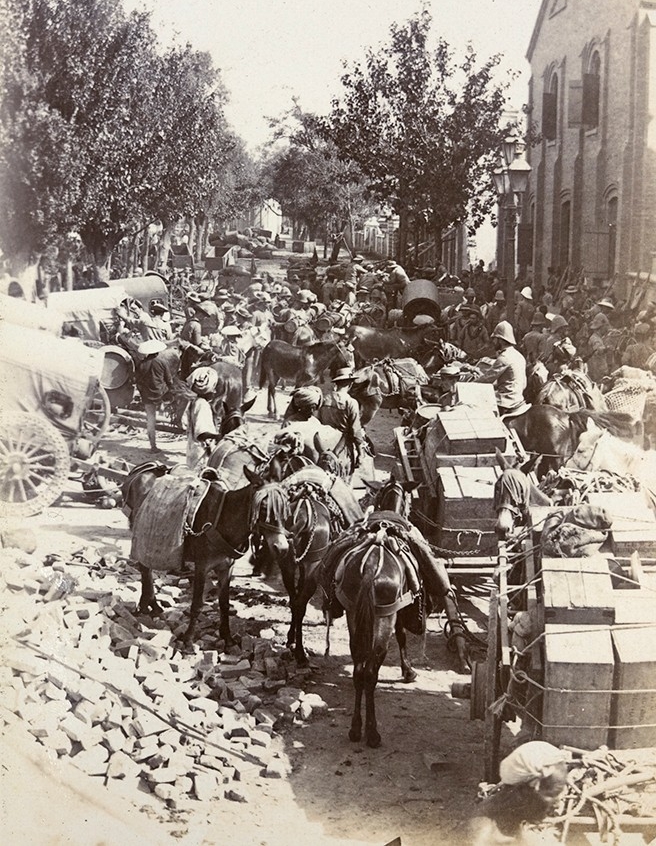
Supply convoy departs Tianjin for Beijing. (The National Archives, London, UK, C0 1069, www.hpcbristol.net/visual/na03-26.)
Major William P. Biddle had command of the two Marine battalions, which totaled 29 commissioned officers and 453 enlisted men. Major Littleton Waller commanded the 1st Battalion with companies A, C, and H. Waller was back in command because Colonel Mead had been relieved by a medical survey board due to rheumatism and sent for treatment at the Mare Island Hospital.[82] Captain F. M. Moses commanded the 2nd Battalion with companies D, I, and F. A guard of 185 Marines remained in Tianjin, along with most of the 6th Cavalry, whose horses had not arrived in time for the march.[83]
The failed Seymour Expedition had followed the railroad, but the allies knew the line would be destroyed beyond the bridge crossing the Hai River. Instead, they decided to follow the Hai River and attack Beijing from the east. The river, rather than the railroad, would be their line of communication with Tianjin.
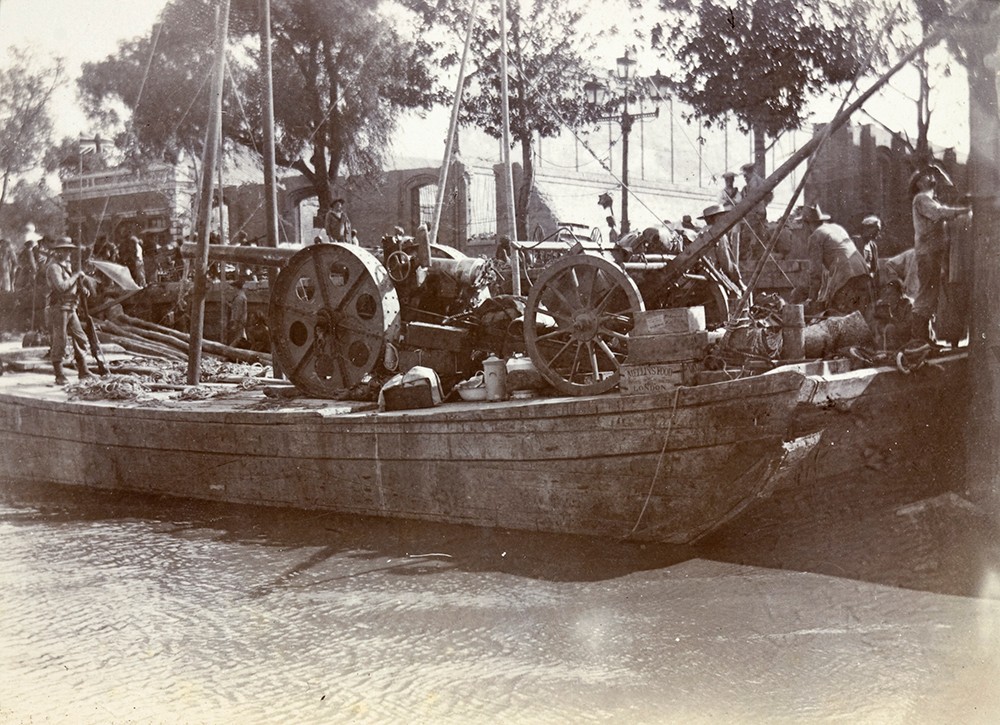
Ordnance on a boat bound for Beijing. (The National Archives, London, UK, C0 1069/423, www.hpcbristol.net/visual/na03-27.)
Battle of Beicang, 5 August 1900
The China Relief Expedition bivouacked for the night near the Xigu Arsenal, which had been captured during the Seymour Expedition. Japanese reconnaissance reported a mix of Chinese troops and Boxers entrenched along the Hai River near the village of Beicang (Peitsang) in a line extending three miles westward to another arsenal.
At 0100 on 5 August, the allied forces advanced toward Beicang, the Russians and French on the left bank of the Hai River, and the Japanese, British, and Americans on the right. The Japanese, followed by the British and the Americans, planned to destroy the arsenal, then advance toward the river and attack the trenches.
When the Japanese reached the arsenal, they found the ground too constricted for them to wait for the rest of their column. They attacked the arsenal and began to chase the Chinese troops to the river. At about 0500, the Japanese sent a message asking for the British and Americans to face north and attack the Chinese. To get into position, the Americans had to march around the British and, by that time, the Chinese had retreated.[84]
Battle of Yangcun, 6 August 1900
The next major town along the Hai River was Yangcun (Yangtsun). The Japanese had borne the brunt of the casualties at Beicang, and so the Americans and the British would spearhead the main attack at Yangcan.
At about 0600 on 6 August, the main arm of the allies advanced along the left bank of the Hai River in three columns, each having crossed the river on a pontoon bridge built by the Japanese. The American column marched along the railroad track, the 14th Infantry leading, a battalion of the 9th Infantry on the right, two battalions of the 14th on the left, the Marines in the center, and Captain Reilly’s artillery battery between the advance and main column. The other two columns, the British and the Russo-French, marched along the river road running parallel to the railroad. The Japanese marched on their own along the right bank of the river.
About a half mile from Yangcun, the allies encountered the Chinese. Gaselee asked for the 14th Regiment to support the British in attacking the right of the Chinese position while Chaffee led the 9th, the Marines, and Captain Reilly’s battery in attacking the left.
As Chaffee’s forces advanced, Chinese infantry opened fire on their right flank from a village to the northeast. Chaffee moved against the village, but when Gaselee sent two messages requesting immediate support, Chaffee led his forces back toward the railroad, though the village had not been entirely destroyed. Waller reported that changes in direction and objective combined with intense heat and movement through high cornfields led to men dropping from heat exhaustion.
Chaffee ordered the Marines and artillery to a 20-foot-high railroad embankment, and Captain Reilly’s men prepared to fire, but held off when Chaffee saw men of the 14th Regiment climbing the embankment. A minute later, Chinese troops hidden in cornfields fired at short range. Captain Reilly’s artillery and the Marines suppressed the fire.
The 9th Infantry fell in on the right flank of the Marines and artillery. Then, an opportunity to inflict damage on the Chinese arose, but Colonel Coolidge ordered the 9th to withhold fire. Coolidge had mistaken Chinese flags for French ones. His caution was a result of allied communications warning the Americans to look out for Russian and French troops likely to pass the Americans. In reality, neither nation’s forces had advanced beyond their position.
The 14th Infantry, supporting the British, suffered considerable losses, seven killed and 57 wounded. Their advance had brought them to a narrow stretch of ground where the American troops overlapped with the British, causing confusion. When they closed in on the village, they were hit by artillery fire, some of which came from the Russians and the British.[85]
Meanwhile, the 9th Infantry, Marines, and Reilly’s battery continued to the villages north of Yangcun and took them with little-to-no opposition. The Marine’s casualties were one wounded and one dead from the heat. In fact, Company H failed to move on the final village, “being nearly prostrated by the heat in the cornfield.”[86]
Battle of Beijing, 14–16 August 1900
On the march toward Beijing (Peking), the greatest enemy was the heat. Exhausted men from every nation lined the roads during the day and rejoined their units at night. During the 80-mile slog that had started at Tianjin, 120 Marines were detached, 45 were placed on junks, 12 were sent to the hospital, 14 were reported missing, and one was killed. The Marine’s strength dwindled from 482 to 291.[87]
Luckily, resistance from Chinese imperial troops was scattered. In addition, the Boxers had disappeared—a phenomenon Silbey attributes to both their successful decimation of the Chinese Christian population and the heavy rainfall, which brought crops that needed tending.[88]
On 12 August, the Japanese forces blew down the gate to Tongxian (Tungchow), the last village along the Hai River before Beijing. Inside, they found it abandoned. The rest of the allied forces arrived by the afternoon, and the commanders met to plan their final attack. They agreed that on the 13th they would conduct a reconnaissance. The next day, the commanders would concentrate their troops on an advance line and hold a final meeting to coordinate. Each nation would attack a different gate and hope that the foreigners in the legations were still alive.
As evening fell on 13 August, Chinese imperial troops responded to the allied presence outside Beijing’s walls by making a final attempt to break into the legations. Defenders held their barricades and fired on artillery atop the Imperial City Wall and troops swarming outside the British Legation.
That night, under the cover of darkness, the Russians stole a march on the allies. Collaboration had prevailed over rivalries throughout the campaign. But now, close to Beijing, national ambition won out. The Russians wanted to reach Beijing first in the hopes of increasing their influence after the last shot was fired.
By moving first, the Russians suffered the worst of the Chinese defenses. They found themselves pinned down under fire at the Dongbianmen (Tungpienmen), the northeast gate of the outer city—and were still at the gate when General Chaffee arrived at noon on the 14th. He reported the Russians were “in great confusion in the passage, their artillery facing in both directions, and I could see no effort being made to extricate themselves and give passage into the city.”[89] Bugler Calvin P. Titus of the 14th Infantry volunteered to scale the wall overlooking the gate. He found that the Chinese had fled, raised the American flag, and signaled for the soldiers to climb the wall.
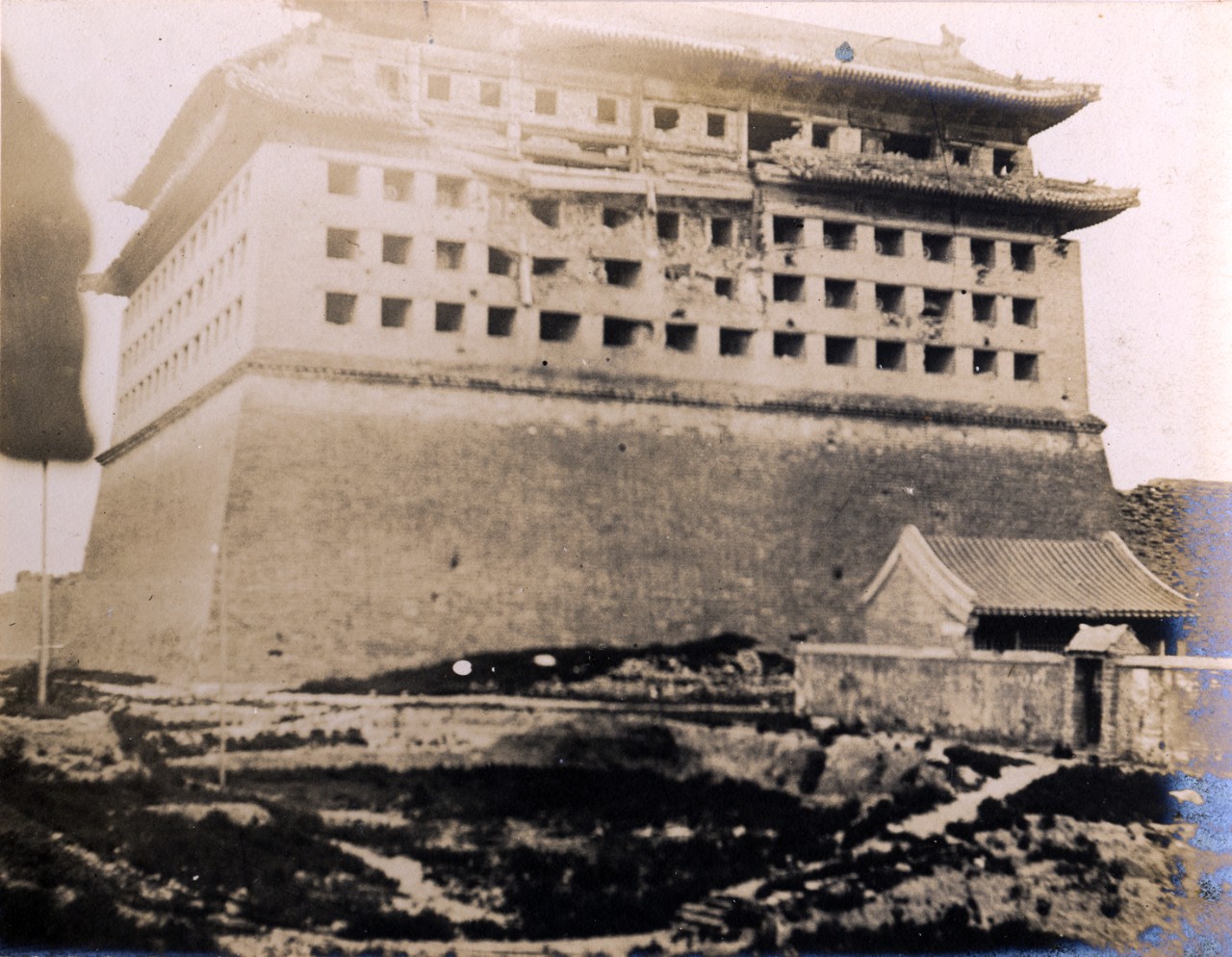
Gate attacked by the Americans at Beijing. (NHHC.)
Captain Reilly’s light battery cleared the wall of Chinese troops, protected by Marines from companies A and H. The 14th Regiment advanced through the city toward the legations. The 9th Regiment followed. At 1500, the Americans marched into the legations only to find the British had gotten there first.[90] Still, they were relieved to see the legation guard alive. The siege had ended.
The casualties among the Marines on 14 August were three wounded, including Lieutenant Smedley Butler, who sustained a chest wound while leading Company A onto the wall. That night, they camped outside the Tartar Wall. Major Waller went to sleep with a bottle of scotch under his pillow, given to him by a Marine officer, but some Marines decided they were in desperate need of a drink. First Lieutenant Frederic Wise Jr., son of Monocacy‘s commander Frederick Wise, stole the bottle from under Waller’s head without waking him, then replaced the now-empty bottle. The Marines chewed coffee beans to cover their tracks.[91]
Beijing was a city of many walls. The allies held part of the Tartar Wall, which surrounded the inner city, including the Legation Quarter. But there was also the Imperial Wall, surrounding the Imperial City, and within that, the walls of the Forbidden City, so named because entrance was forbidden to commoners. Unbeknownst to the allies, the Empress Dowager Cixi and her court had fled the Forbidden City, disguised as a peasants.
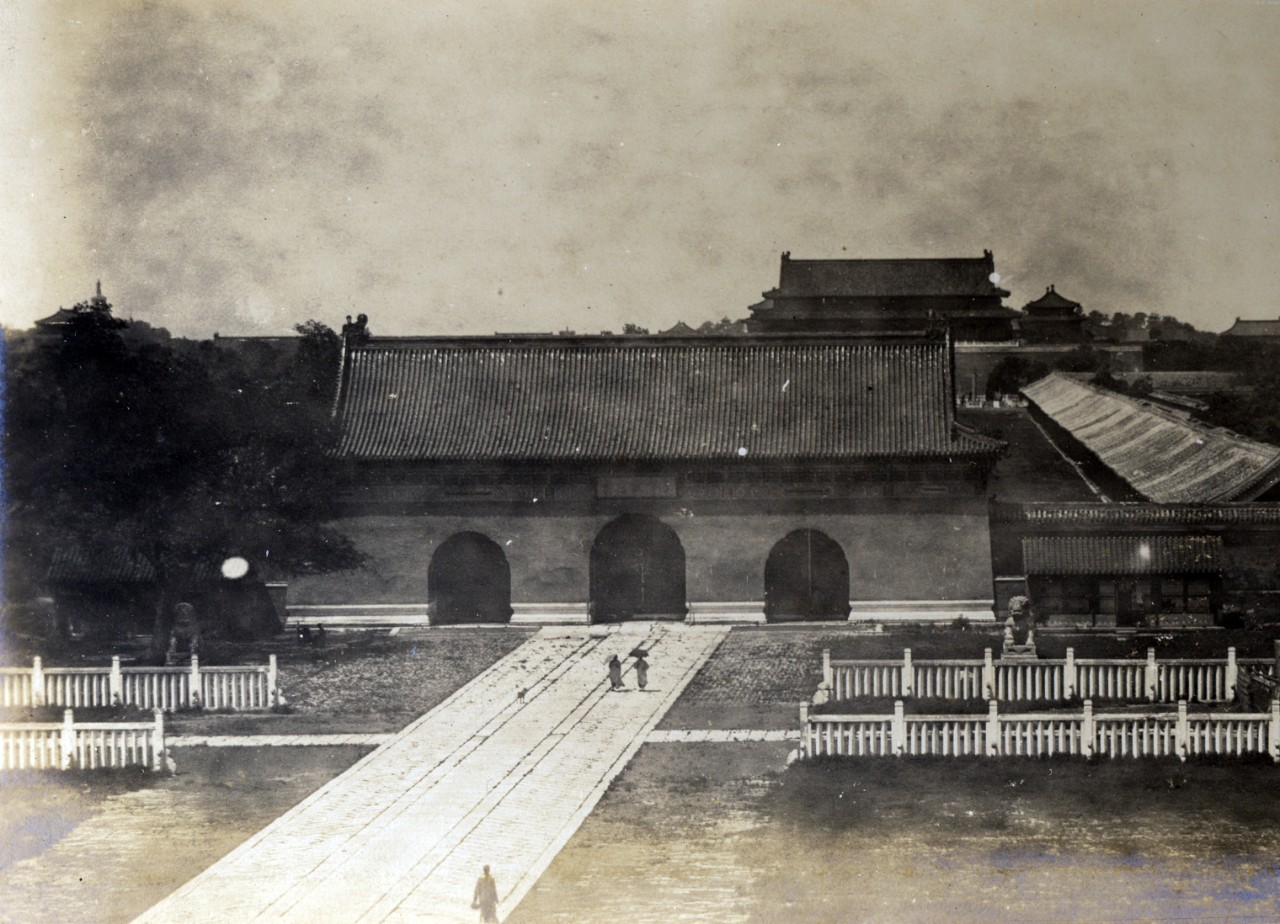
The Imperial City gates. (NHHC.)
On 15 August, the Americans alone attacked the Imperial City. The Marines led the way, clearing barricades on the Tartar Wall so that the artillery could fire from the pagoda atop the Zhengyangmen (Chienmen), the gate guarding the main entrance to the inner city. The Marines had orders to capture flags mounted at the west gate, but the order was revoked when Chinese opened heavy fire from a gate of the Imperial City. Two pieces of Reilly’s artillery fired on the gate, driving out the troops, but in the exchange, Captain Reilly was struck in the mouth by a bullet, dying at Major Waller’s side. Waller wrote of Reilly, “A braver solider, a truer friend never breathed than this admirable and lamented officer. He died at my side, touching me at the moment of the blow. He died without murmur or groan.”[92]
The 14th Regiment scaled the western wall only to find another wall, and yet another wall. They pressed forward, nearing the gates of the Forbidden City when the allied commanders insisted on a war council and decided not to occupy the Imperial City that day. Chaffee withdrew his troops from inside the city, the Marines holding their position on the Zhengyangmen.
The next day, 16 August, the forces of the eight-nation alliance moved into the Forbidden City.
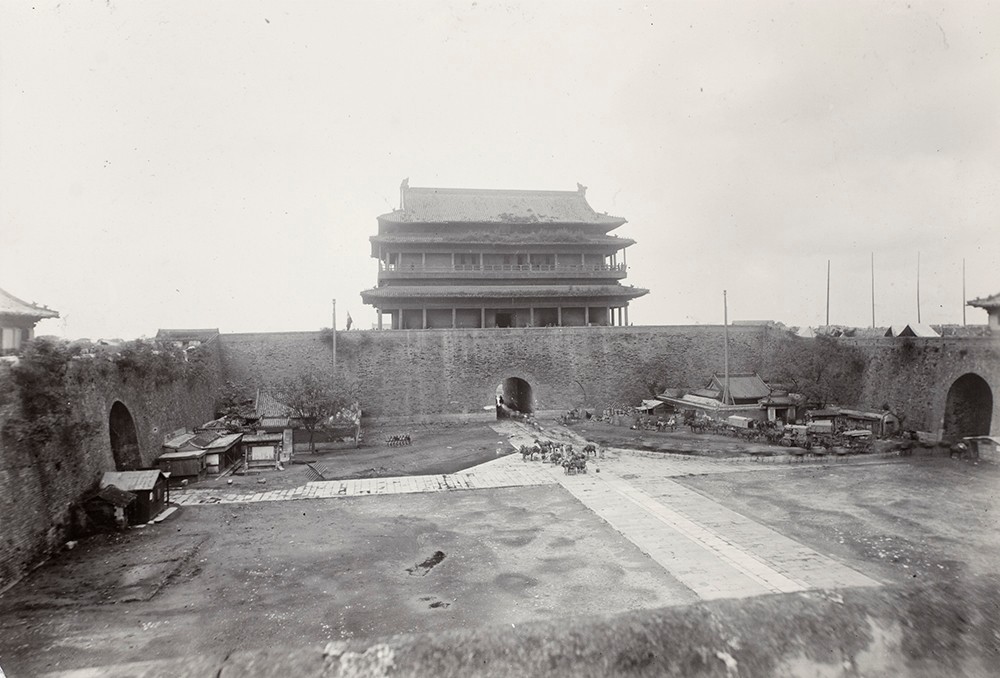
Pagoda atop the Zhengyangmen, the main gate to the inner city. (The National Archives, London, UK, C0 1069/425, www.hpcbristol.net/visual/na05-16.)
Aftermath, 1900–1911
The allies quickly divided the city and imposed martial law, the Americans occupying the southwest corner of Beijing. As at Tianjin, looting in Beijing became rampant and difficult to control. Although historians agree the British and Americans were “the least brutal in their behavior,” the Americans were not without fault.[93] One Marine private, Stephan Dwyar, was charged with rape and assault. General Chaffee cracked down hard on such cases, and Dwyar was sentenced to 20 years’ imprisonment at Alcatraz.[94]
Under Chaffee, the American occupation included providing vaccinations, cleaning latrines, constructing shelters for the poor, setting up food kitchens, and offering health checks for prostitutes. Chinese inhabitants moved into the American sector from other parts of Beijing, resulting in a housing shortage.[95]
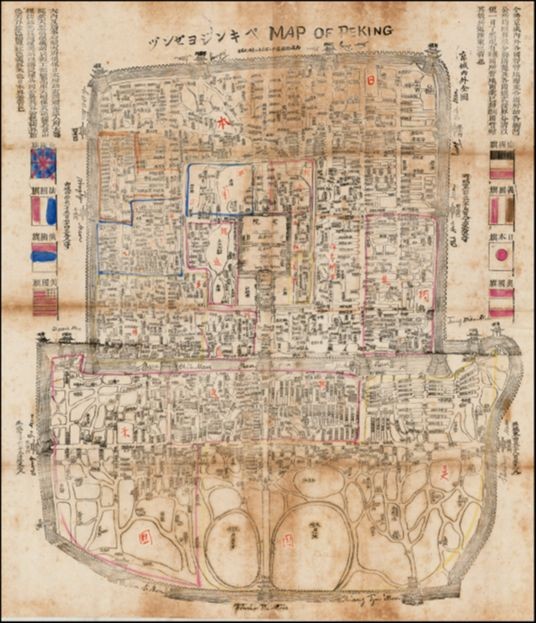
Map of Beijing hastily created by the Japanese army shortly after the allied occupation. Hand-colored flags represent each member of the Eight-Nation Alliance, and colored outlines show the areas of the city controlled by each nation: the United States, Austria-Hungary, Great Britain, France, Germany, Italy, Japan, and Russia. (Courtesy, Barry Lawrence Ruderman Map Collection, David Rumsey Map Center, Stanford Libraries, purl.stanford.edu/ps095pv0584.)
After a year’s worth of negotiations between the allies and the Chinese, a treaty known as the Boxer Protocol was signed in September 1901. It mandated that the Chinese would have to pay 450 million taels (about $350 million then, over $11 billion today) over 39 years, a tael for each of China’s estimated population of 450 million. The Russians would receive the largest share, over 28 percent, while the Americans were to receive about 7 percent, which they dedicated to education funding for foreign students. At the end of the 39-year period, in 1940, the Chinese had paid an estimated $600–$700 million due to the accrual of interest.[96]
The Boxer Protocol also further opened China to foreign influence. The Chinese had to destroy the Dagu Forts, allow foriegn powers to occupy points along the Hai River, comply with a two-year ban on weapons imports, and grant the foreign powers exclusive control of the Legation Quarter. In addition, the Boxer Protocol exacted punishment on pro-Boxer Chinese leaders. Qing officials had crafted an alternate history in which Empress Dowager Cixi had been held captive in her court, forced to back the Boxers against her will. Prince Duan, the conservative head of the Zongli Yamen, became the Qing dynasty’s scapegoat and was exiled. Meanwhile, some junior courtiers were condemned to commit suicide, and those who had already died were subject to “posthumous degradation.” To atone for the murders of German minister Baron von Ketteler and Japanese chancellor Sugiyama Akira, Chinese ambassadors had to travel to Germany and Japan to apologize. Furthermore, the Chinese were required to erect a monument for von Ketteler at the location of his assassination with an inscription expressing regret in Latin, German, and Chinese.[97]
In January 1902, Empress Dowager Cixi returned to Beijing and began to implement the very reforms that in 1898 had led her to overthrow her nephew and execute his advisors. The Boxer Rebellion had weakened the Chinese central government, and only a few years after Cixi’s death in 1908, the 1911 Revolution ended China’s last imperial dynasty and established the Republic of China.
Significance for the Navy and Marines
After the occupation of Beijing, the Navy reduced its presence in China, but did not disappear entirely. Monocacy, which had supported the U.S. military force at Tanggu, went into a mud dock in the Hai River during the winter. New Orleans also remained in North China, assisting the army and transporting mail from Nagasaki. Two monitors with full complements were stationed permanently in China, Monadnock at Shanghai and Monterey at Guangzhou (Canton). The Boxer Rebellion also expedited the expansion of a U.S. naval hospital in Yokohama, Japan.[98]
On 11 October 1900, all Marines were withdrawn from China. The total number of Marines sent to China for the Boxer Rebellion was 49 officers and 1,151 enlisted men. Twenty-two sailors and 33 Marines earned Medals of Honor for their actions. Marine Corps officers were not eligible for Medals of Honor until 1913, and so distinguished officers were “advanced in numbers” in their rank. Captain John Myers was advanced four precedence numbers and brevetted a major, and Lieutenant Smedley Butler was advanced two numbers and brevetted a captain.[99] Butler would go on to join Dan Daly as one of only two Marines to receive a Medal of Honor for separate actions, the first at Veracruz in 1914 and the second at Haiti in 1915.[100]
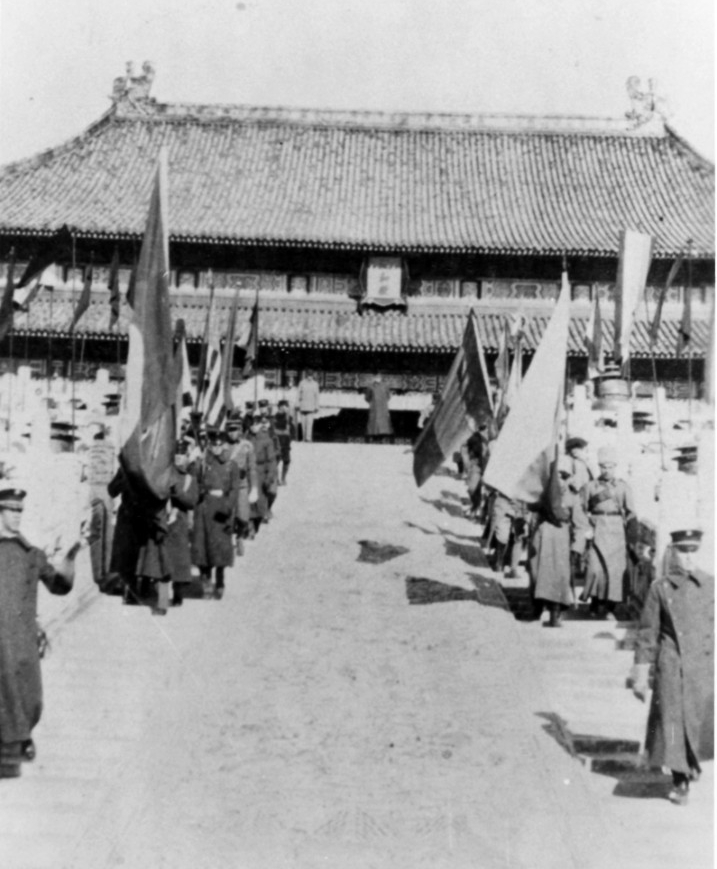
U.S. Marines leading a parade of the Allies in the Forbidden City after the relief of the Legation Quarter. (NHHC NH-2796.)
The Boxer Rebellion may have been a small war, but it was the American military’s first taste of coalition warfare. The allied commanders cooperated (for the most part) despite rivalries, conflicting orders, and language barriers. Leonhard writes that the challenges faced by the Americans—inadequate staffing, educational shortfalls, and language deficiencies—would continue to plague coalition warfare through the twentieth century.
The Boxer Rebellion was also a test in cooperation between the different branches of service. According to Leonhard, the collaboration between the Army, Navy, and Marine Corps was a testament to the character of the soldiers, sailors, and Marines, and not to the state of American joint warfare capabilities, as “in 1900, joint cooperation remained a matter of personal negotiation and inter-service politics.”[101]
The allied forces were not guaranteed victory in China. Silbey notes that if not for the discovery of sorely needed supplies at the Xigu Arsenal, the entire Seymour Expedition could have been killed or captured. At the Battle of Tianjin, an allied defeat seemed likely after the first day of fighting, an outcome prevented by Japan’s nighttime assault. And at the besieged Legation Quarter in Beijing, U.S. Marines held a critical and precarious position atop the Tartar Wall, which could have fallen had the Chinese mounted a full-scale attack.[102] Victory for the allies in the blistering summer of 1900 was made possible by luck and by the brave actions of individuals in the face of seemingly impossible odds.